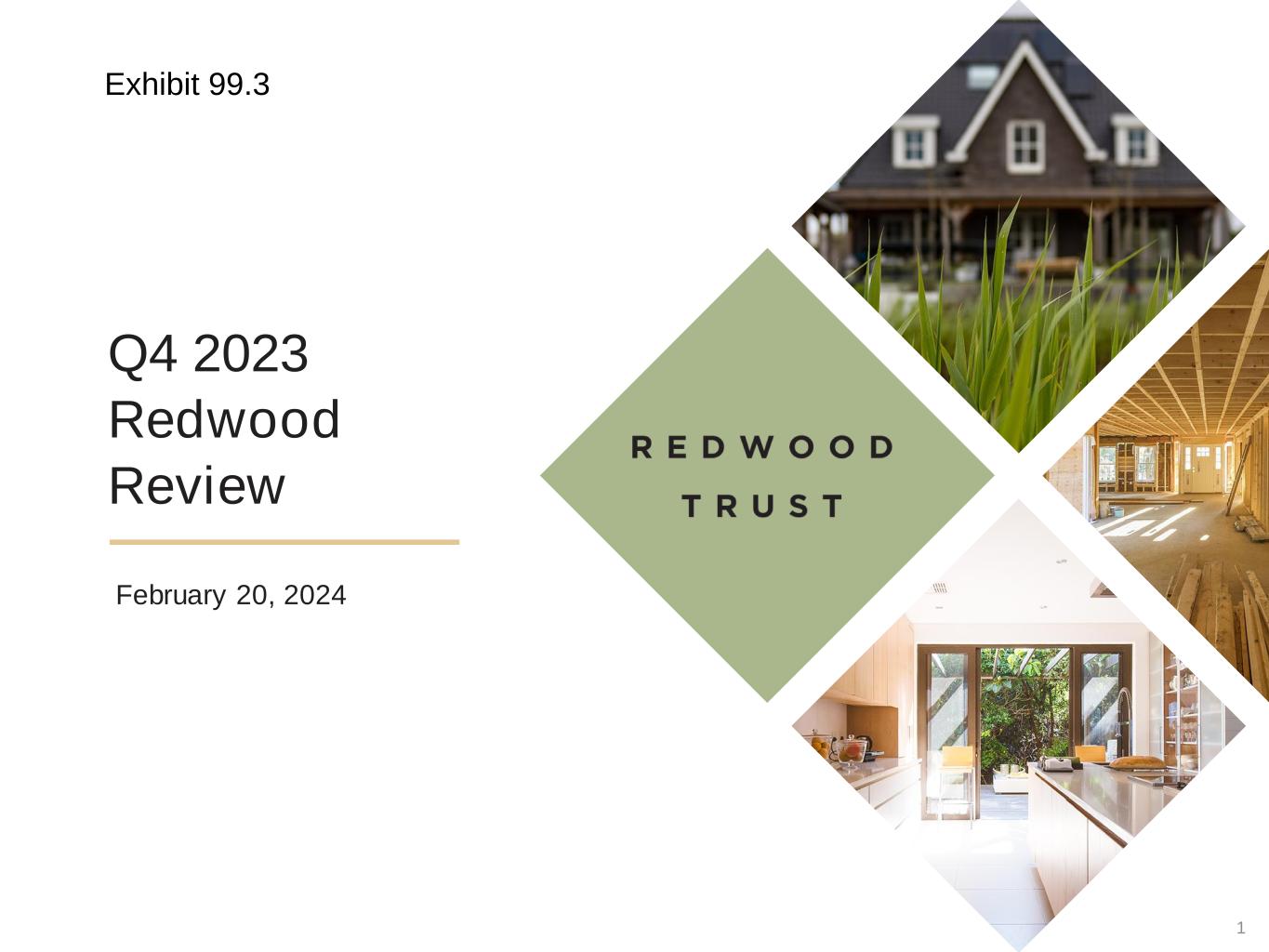
1 Q4 2023 Redwood Review February 20, 2024
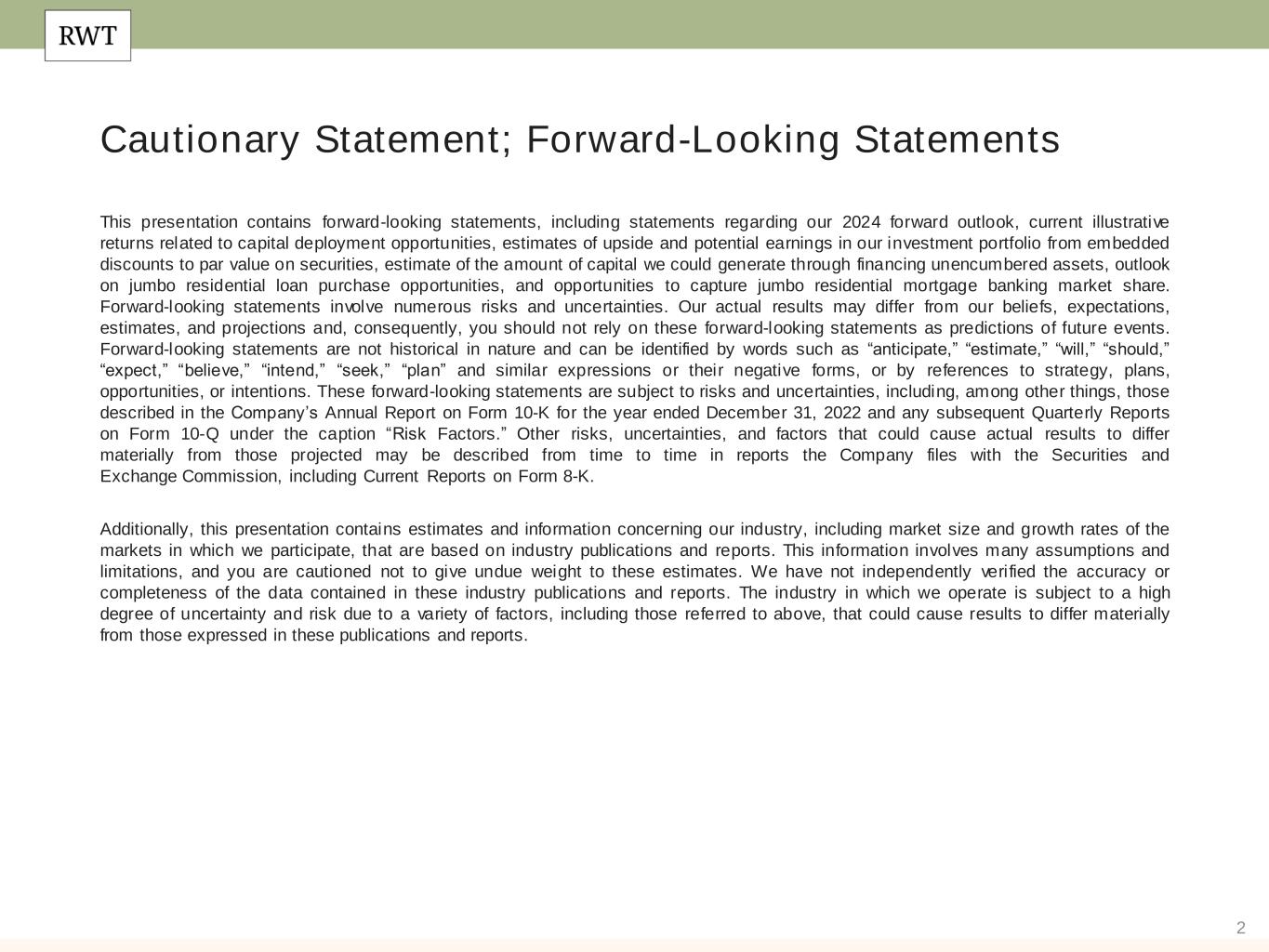
2 Cautionary Statement; Forward-Looking Statements This presentation contains forward-looking statements, including statements regarding our 2024 forward outlook, current illustrative returns related to capital deployment opportunities, estimates of upside and potential earnings in our investment portfolio from embedded discounts to par value on securities, estimate of the amount of capital we could generate through financing unencumbered assets, outlook on jumbo residential loan purchase opportunities, and opportunities to capture jumbo residential mortgage banking market share. Forward-looking statements involve numerous risks and uncertainties. Our actual results may differ from our beliefs, expectations, estimates, and projections and, consequently, you should not rely on these forward-looking statements as predictions of future events. Forward-looking statements are not historical in nature and can be identified by words such as “anticipate,” “estimate,” “will,” “should,” “expect,” “believe,” “intend,” “seek,” “plan” and similar expressions or their negative forms, or by references to strategy, plans, opportunities, or intentions. These forward-looking statements are subject to risks and uncertainties, including, among other things, those described in the Company’s Annual Report on Form 10-K for the year ended December 31, 2022 and any subsequent Quarterly Reports on Form 10-Q under the caption “Risk Factors.” Other risks, uncertainties, and factors that could cause actual results to differ materially from those projected may be described from time to time in reports the Company files with the Securities and Exchange Commission, including Current Reports on Form 8-K. Additionally, this presentation contains estimates and information concerning our industry, including market size and growth rates of the markets in which we participate, that are based on industry publications and reports. This information involves many assumptions and limitations, and you are cautioned not to give undue weight to these estimates. We have not independently verified the accuracy or completeness of the data contained in these industry publications and reports. The industry in which we operate is subject to a high degree of uncertainty and risk due to a variety of factors, including those referred to above, that could cause results to differ materially from those expressed in these publications and reports.
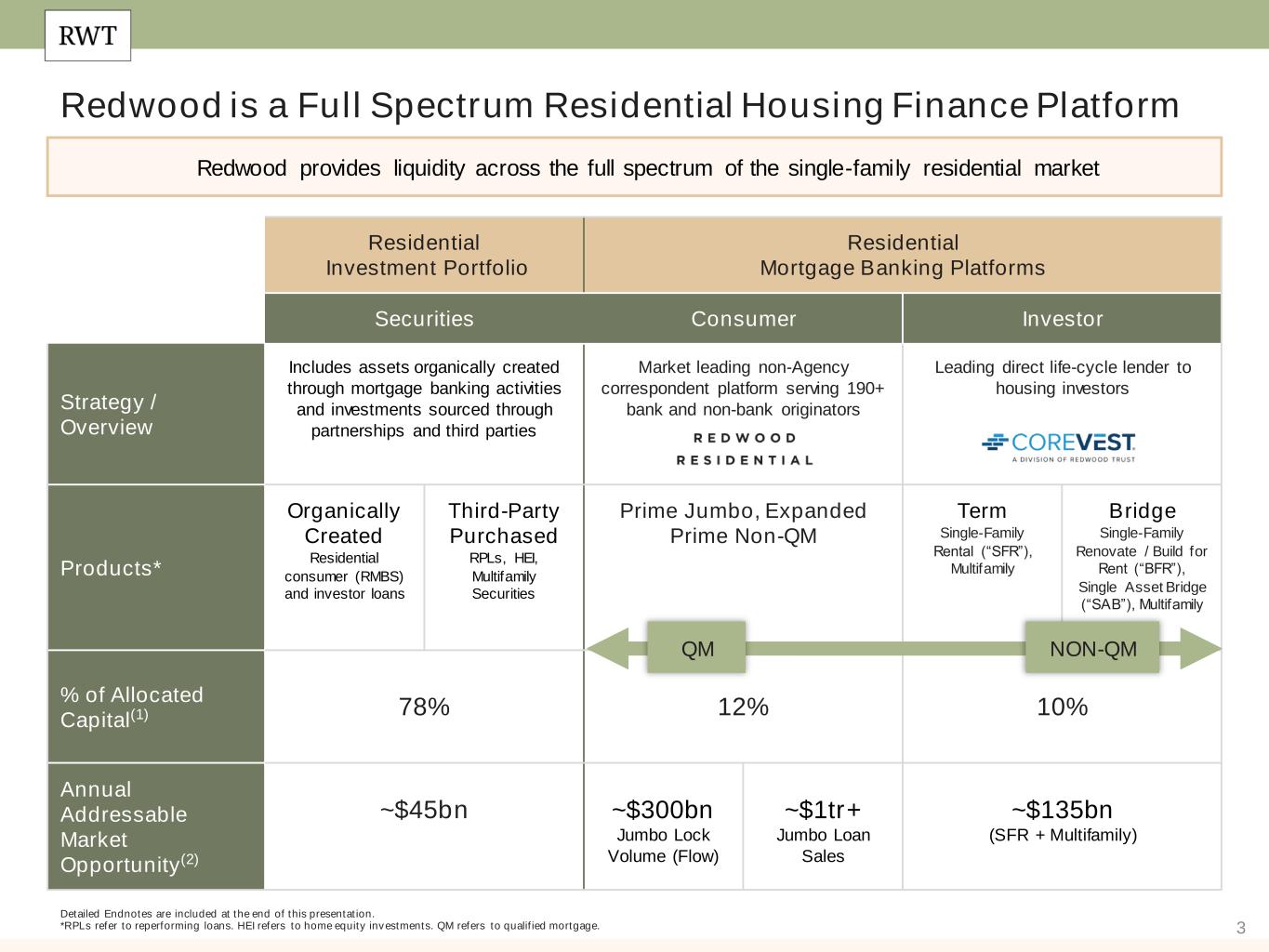
3 Redwood is a Full Spectrum Residential Housing Finance Platform Residential Investment Portfolio Residential Mortgage Banking Platforms Securities Consumer Investor Strategy / Overview Includes assets organically created through mortgage banking activities and investments sourced through partnerships and third parties Market leading non-Agency correspondent platform serving 190+ bank and non-bank originators Leading direct life-cycle lender to housing investors Products* Organically Created Residential consumer (RMBS) and investor loans Third-Party Purchased RPLs, HEI, Multifamily Securities Prime Jumbo, Expanded Prime Non-QM Term Single-Family Rental (“SFR”), Multifamily Bridge Single-Family Renovate / Build for Rent (“BFR”), Single Asset Bridge (“SAB”), Multifamily % of Allocated Capital(1) 78% 12% 10% Annual Addressable Market Opportunity(2) ~$45bn ~$300bn Jumbo Lock Volume (Flow) ~$1tr+ Jumbo Loan Sales ~$135bn (SFR + Multifamily) Redwood provides liquidity across the full spectrum of the single-family residential market Detailed Endnotes are included at the end of this presentation. *RPLs refer to reperforming loans. HEI refers to home equity investments. QM refers to qualified mortgage. QM NON-QM
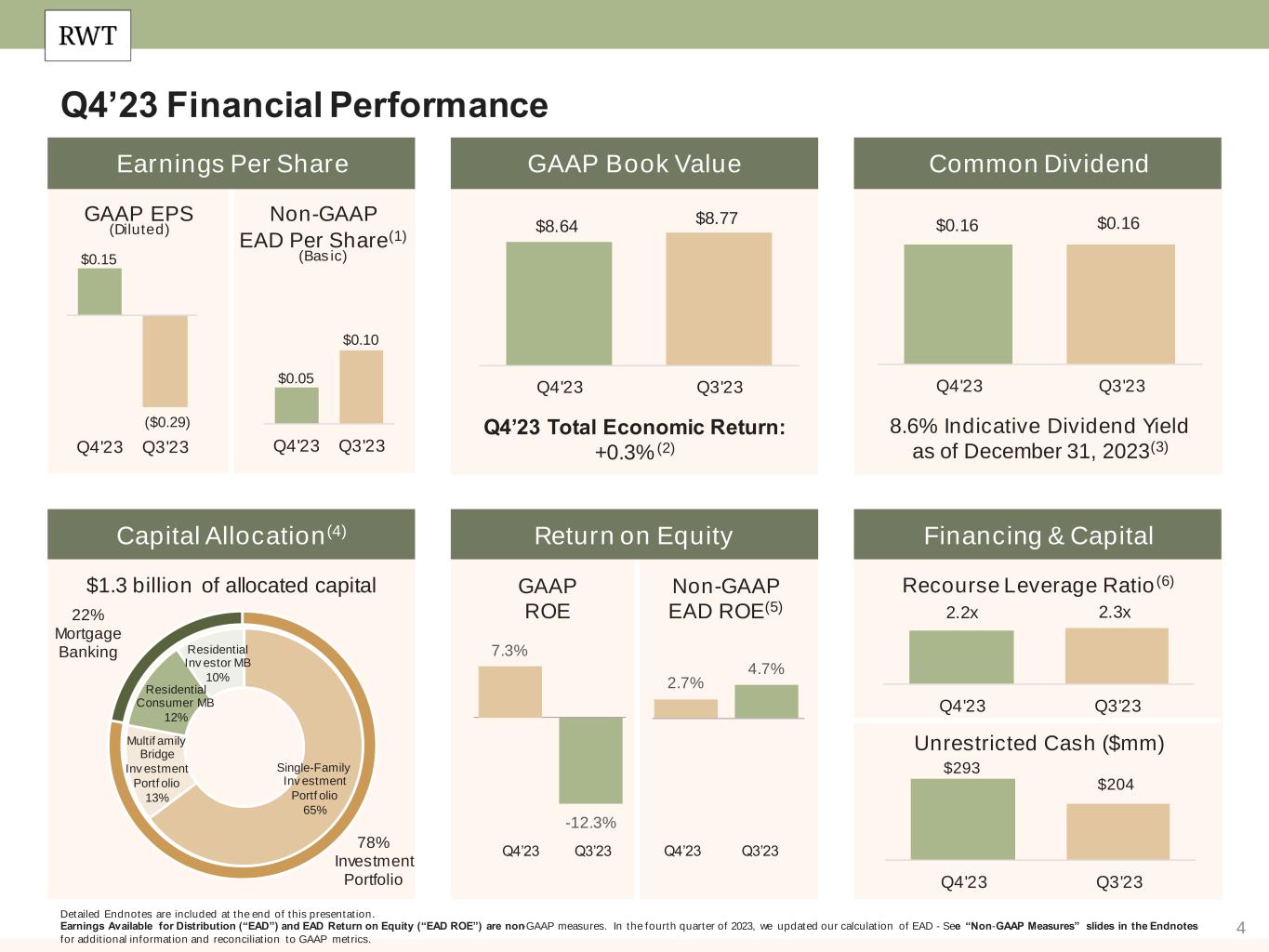
4 Q4’23 Financial Performance Detailed Endnotes are included at the end of this presentation. Earnings Available for Distribution (“EAD”) and EAD Return on Equity (“EAD ROE”) are non-GAAP measures. In the fourth quarter of 2023, we updated our calculation of EAD - See “Non-GAAP Measures” slides in the Endnotes for additional information and reconciliation to GAAP metrics. Recourse Leverage Ratio(6) Unrestricted Cash ($mm) Q4’23 Total Economic Return: +0.3% (2) 8.6% Indicative Dividend Yield as of December 31, 2023(3) GAAP ROE Non-GAAP EAD ROE(5) GAAP EPS (Diluted) Non-GAAP EAD Per Share(1) (Basic) Q4’23 Q3’23 Q4’23 Q3’23 $8.64 $8.77 Q4'23 Q3'23 $0.05 $0.10 Q4'23 Q3'23 $0.15 ($0.29) Q4'23 Q3'23 2.2x 2.3x Q4'23 Q3'23 $0.16 $0.16 Q4'23 Q3'23 $293 $204 Q4'23 Q3'23 7.3% 2.7% -12.3% 4.7% Earnings Per Share GAAP Book Value Common Dividend Capital Allocation(4) Return on Equity Financing & Capital $1.3 billion of allocated capital 78% Investment Portfolio 22% Mortgage Banking Single-Family Inv estment Portf olio 65% Multif amily Bridge Inv estment Portf olio 13% Residential Consumer MB 12% Residential Inv estor MB 10%
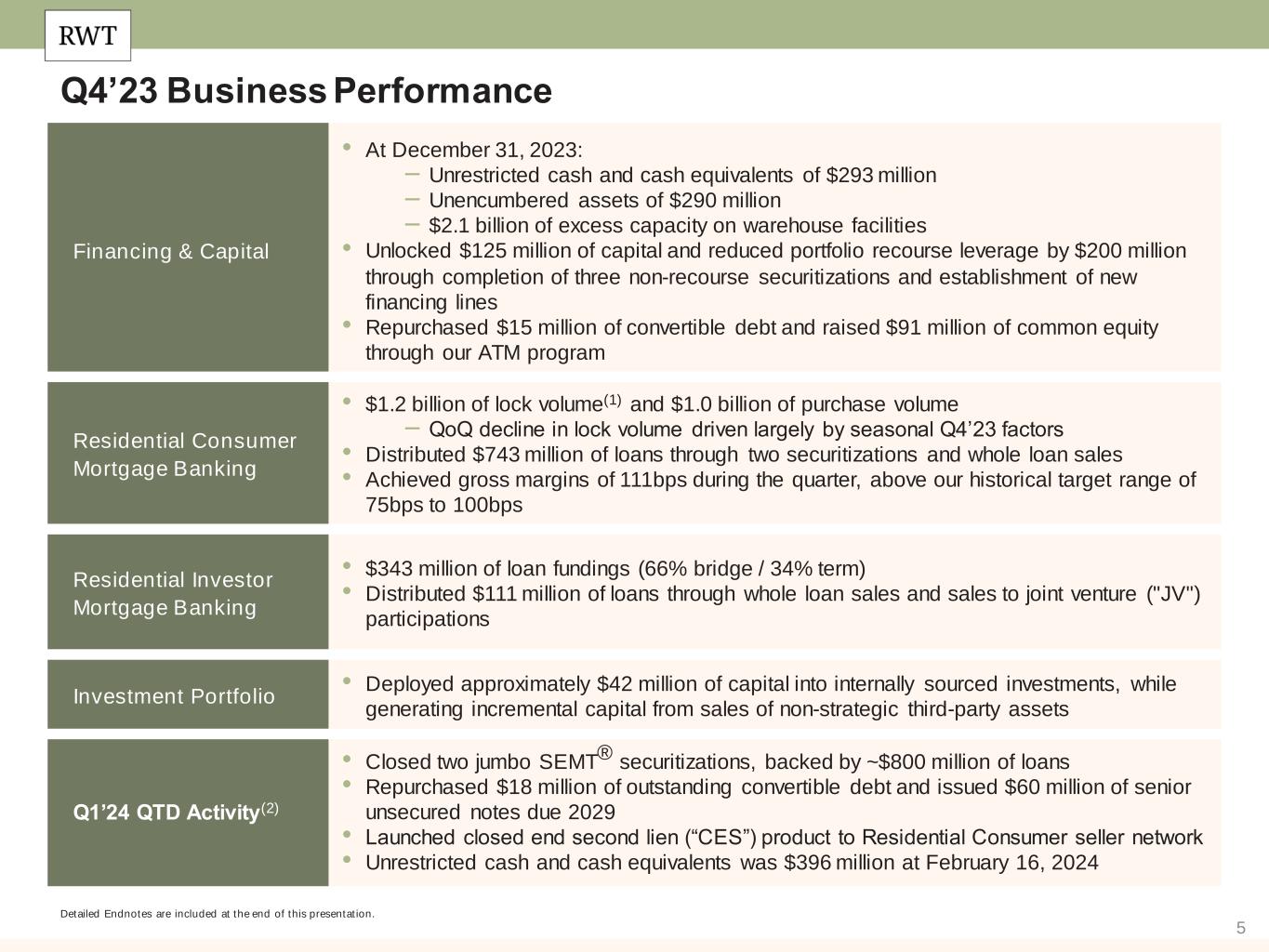
5 Q4’23 Business Performance Financing & Capital • At December 31, 2023: – Unrestricted cash and cash equivalents of $293 million – Unencumbered assets of $290 million – $2.1 billion of excess capacity on warehouse facilities • Unlocked $125 million of capital and reduced portfolio recourse leverage by $200 million through completion of three non-recourse securitizations and establishment of new financing lines • Repurchased $15 million of convertible debt and raised $91 million of common equity through our ATM program Residential Consumer Mortgage Banking • $1.2 billion of lock volume(1) and $1.0 billion of purchase volume – QoQ decline in lock volume driven largely by seasonal Q4’23 factors • Distributed $743 million of loans through two securitizations and whole loan sales • Achieved gross margins of 111bps during the quarter, above our historical target range of 75bps to 100bps Residential Investor Mortgage Banking • $343 million of loan fundings (66% bridge / 34% term) • Distributed $111 million of loans through whole loan sales and sales to joint venture ("JV") participations Investment Portfolio • Deployed approximately $42 million of capital into internally sourced investments, while generating incremental capital from sales of non-strategic third-party assets Q1’24 QTD Activity(2) • Closed two jumbo SEMT® securitizations, backed by ~$800 million of loans • Repurchased $18 million of outstanding convertible debt and issued $60 million of senior unsecured notes due 2029 • Launched closed end second lien (“CES”) product to Residential Consumer seller network • Unrestricted cash and cash equivalents was $396 million at February 16, 2024 Detailed Endnotes are included at the end of this presentation.
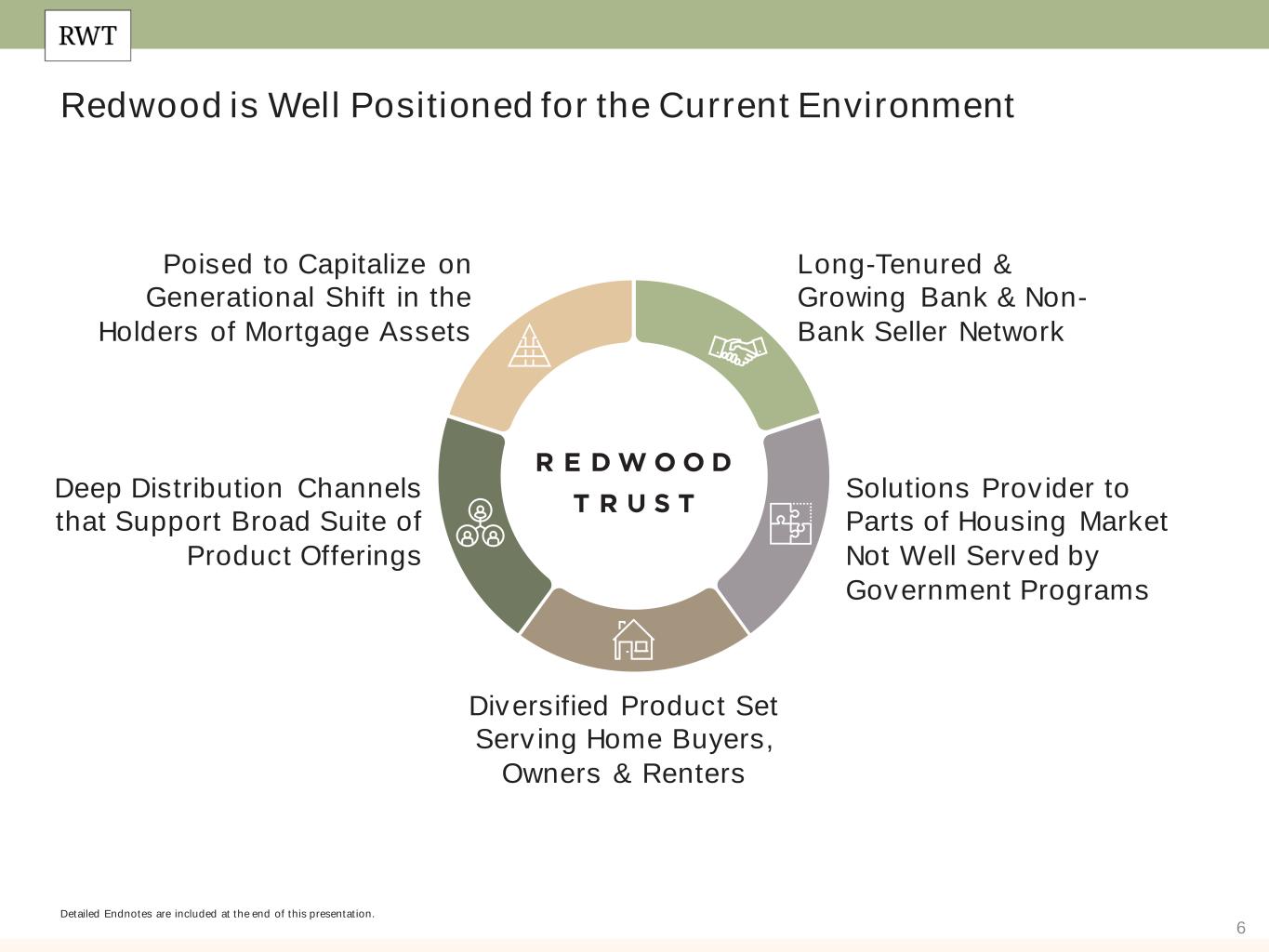
6 Redwood is Well Positioned for the Current Environment Detailed Endnotes are included at the end of this presentation. Poised to Capitalize on Generational Shift in the Holders of Mortgage Assets Deep Distribution Channels that Support Broad Suite of Product Offerings Diversified Product Set Serving Home Buyers, Owners & Renters Long-Tenured & Growing Bank & Non- Bank Seller Network Solutions Provider to Parts of Housing Market Not Well Served by Government Programs
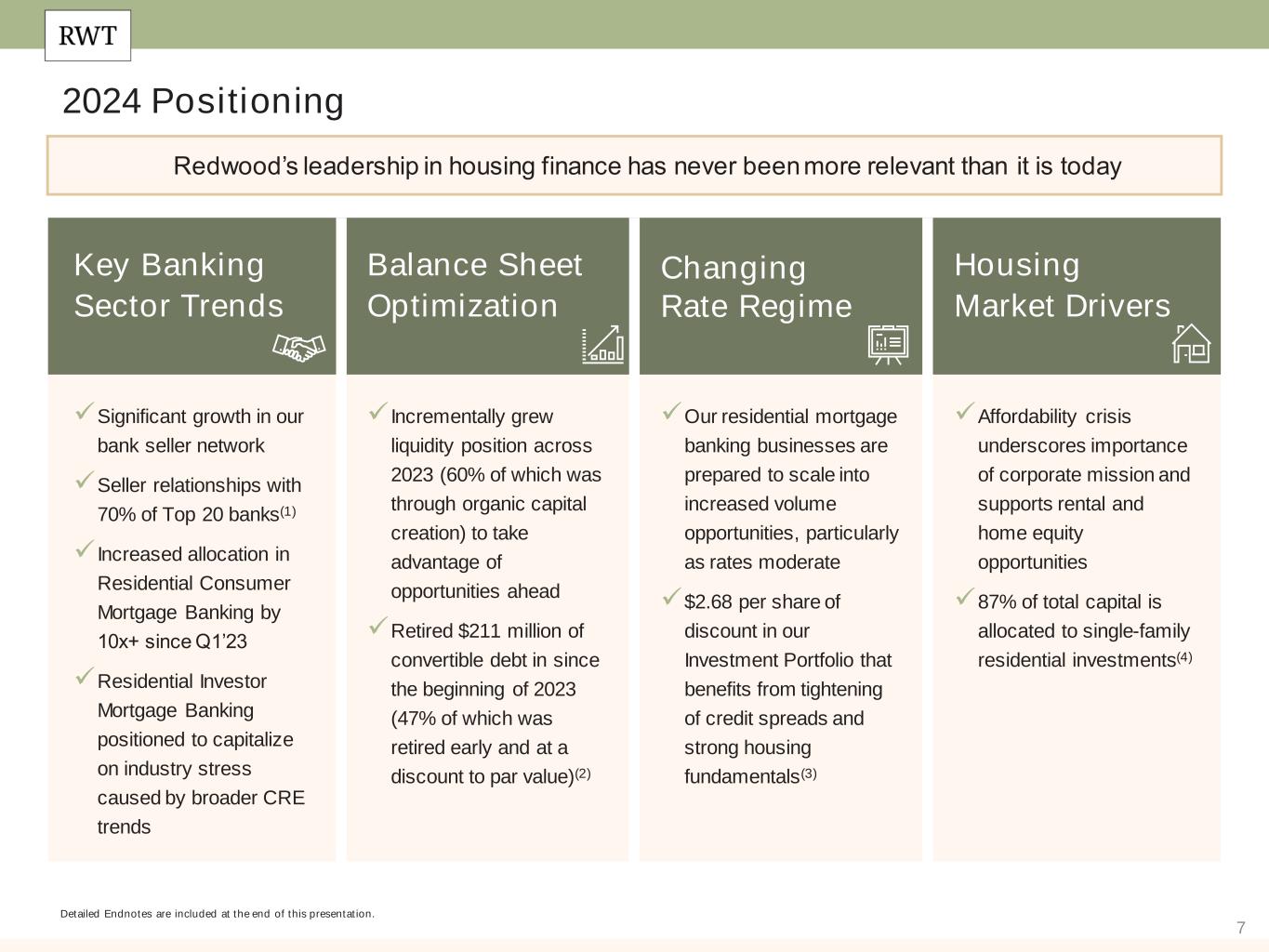
7 2024 Positioning Redwood’s leadership in housing finance has never been more relevant than it is today Our investment portfolio is well positioned for the current environment with $2.68 of discount in our investment portfolio that benefits from tightening of credit spreads and strong housing fundamentals Housing Credit Key Banking Sector Trends Balance Sheet Optimization Changing Rate Regime Housing Market Drivers ✓Significant growth in our bank seller network ✓Seller relationships with 70% of Top 20 banks(1) ✓ Increased allocation in Residential Consumer Mortgage Banking by 10x+ since Q1’23 ✓Residential Investor Mortgage Banking positioned to capitalize on industry stress caused by broader CRE trends ✓ Incrementally grew liquidity position across 2023 (60% of which was through organic capital creation) to take advantage of opportunities ahead ✓Retired $211 million of convertible debt in since the beginning of 2023 (47% of which was retired early and at a discount to par value)(2) ✓Our residential mortgage banking businesses are prepared to scale into increased volume opportunities, particularly as rates moderate ✓$2.68 per share of discount in our Investment Portfolio that benefits from tightening of credit spreads and strong housing fundamentals(3) ✓Affordability crisis underscores importance of corporate mission and supports rental and home equity opportunities ✓87% of total capital is allocated to single-family residential investments(4) Detailed Endnotes are included at the end of this presentation.
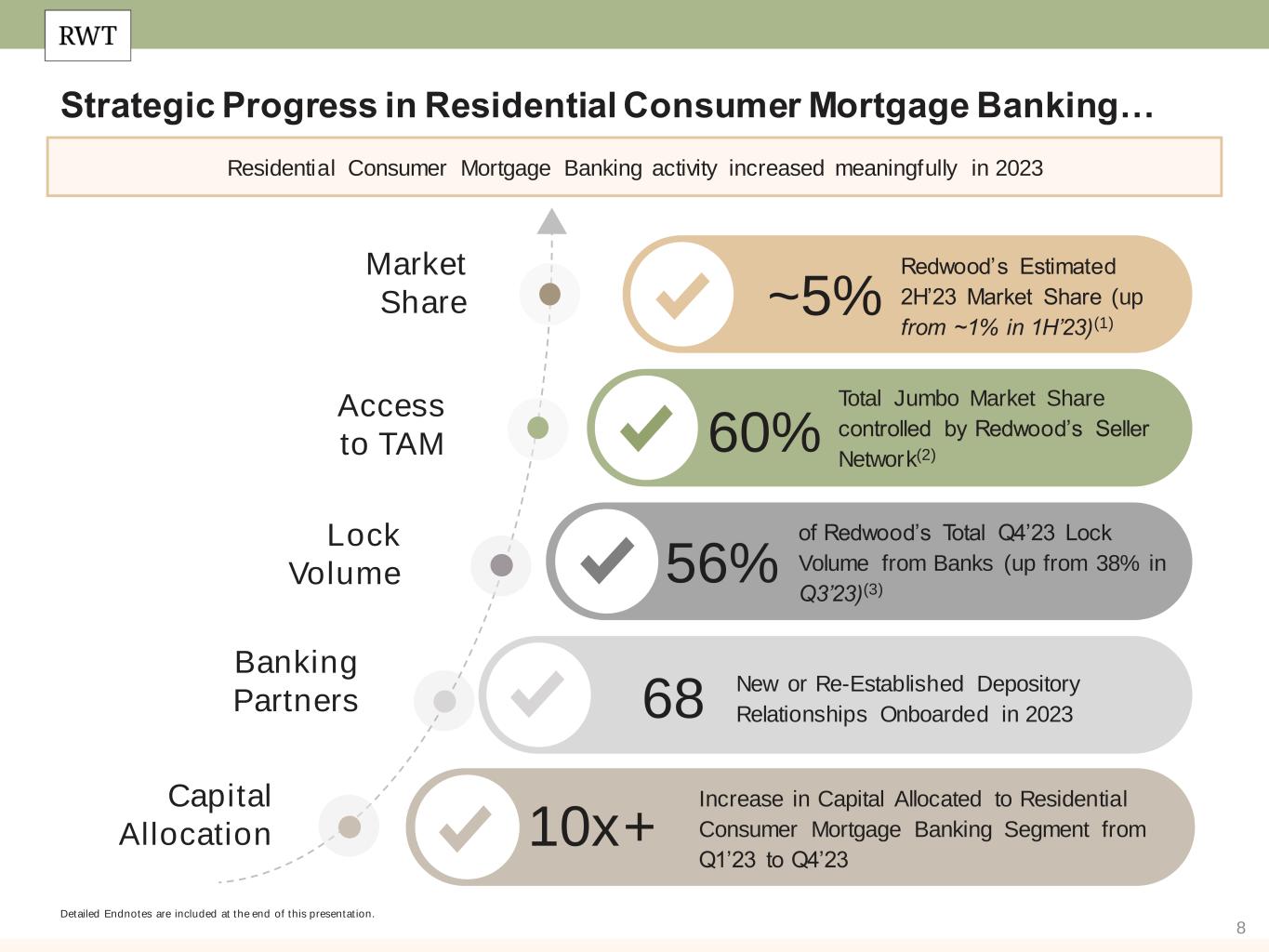
8 Strategic Progress in Residential Consumer Mortgage Banking… Detailed Endnotes are included at the end of this presentation. Residential Consumer Mortgage Banking activity increased meaningfully in 2023 Market Share Access to TAM Lock Volume Banking Partners 68 56% 60% ~5% Redwood’s Estimated 2H’23 Market Share (up from ~1% in 1H’23)(1) of Redwood’s Total Q4’23 Lock Volume from Banks (up from 38% in Q3’23)(3) New or Re-Established Depository Relationships Onboarded in 2023 Total Jumbo Market Share controlled by Redwood’s Seller Network(2) Capital Allocation 10x+ Increase in Capital Allocated to Residential Consumer Mortgage Banking Segment from Q1’23 to Q4’23
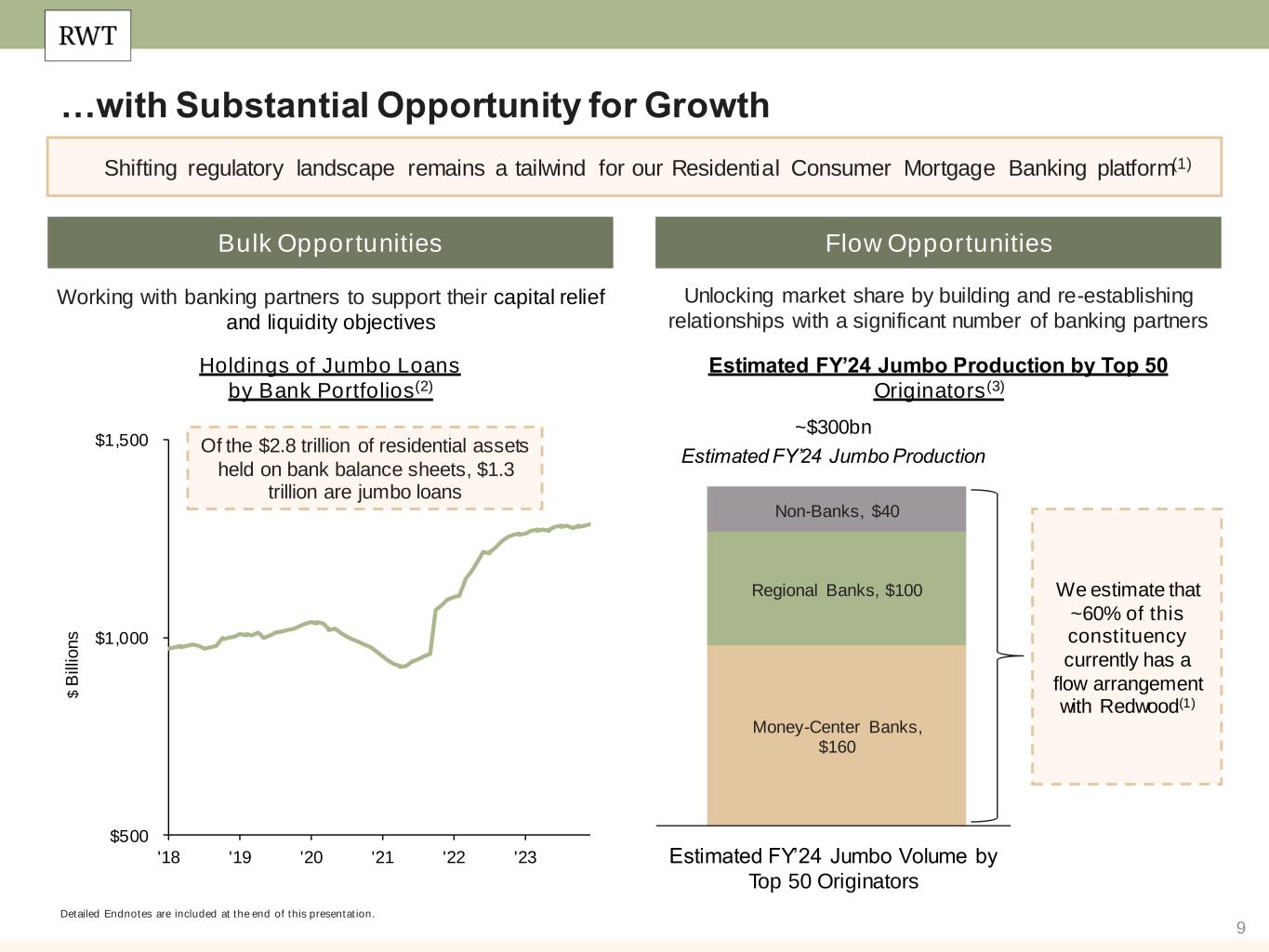
9 Money-Center Banks, $160 Regional Banks, $100 Non-Banks, $40 $500 $1,000 $1,500 '18 '19 '20 '21 '22 '23 $ B ill io n s …with Substantial Opportunity for Growth Detailed Endnotes are included at the end of this presentation. Shifting regulatory landscape remains a tailwind for our Residential Consumer Mortgage Banking platform(1) Of the $2.8 trillion of residential assets held on bank balance sheets, $1.3 trillion are jumbo loans ~$300bn Estimated FY’24 Jumbo Production We estimate that ~60% of this constituency currently has a flow arrangement with Redwood(1) Flow OpportunitiesBulk Opportunities Estimated FY’24 Jumbo Production by Top 50 Originators(3) Holdings of Jumbo Loans by Bank Portfolios(2) Unlocking market share by building and re-establishing relationships with a significant number of banking partners Working with banking partners to support their capital relief and liquidity objectives Estimated FY’24 Jumbo Volume by Top 50 Originators
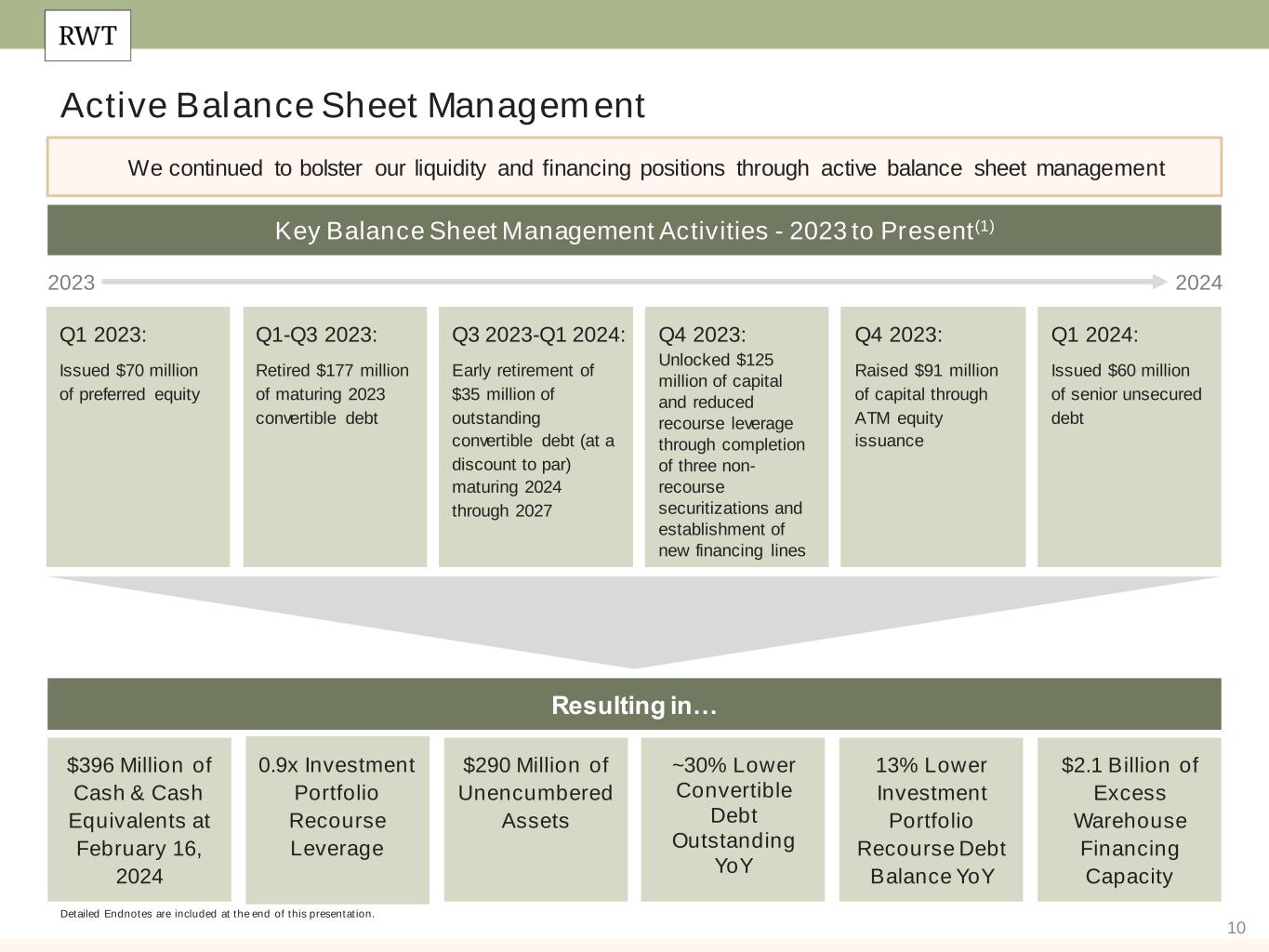
10 Active Balance Sheet Management Detailed Endnotes are included at the end of this presentation. We continued to bolster our liquidity and financing positions through active balance sheet management 2023 Key Balance Sheet Management Activities - 2023 to Present(1) Q1 2023: Issued $70 million of preferred equity Q1 2024: Issued $60 million of senior unsecured debt Q1-Q3 2023: Retired $177 million of maturing 2023 convertible debt Q3 2023-Q1 2024: Early retirement of $35 million of outstanding convertible debt (at a discount to par) maturing 2024 through 2027 Q4 2023: Unlocked $125 million of capital and reduced recourse leverage through completion of three non- recourse securitizations and establishment of new financing lines Q4 2023: Raised $91 million of capital through ATM equity issuance Resulting in… $396 Million of Cash & Cash Equivalents at February 16, 2024 $2.1 Billion of Excess Warehouse Financing Capacity 0.9x Investment Portfolio Recourse Leverage $290 Million of Unencumbered Assets ~30% Lower Convertible Debt Outstanding YoY 13% Lower Investment Portfolio Recourse Debt Balance YoY 2023 2024
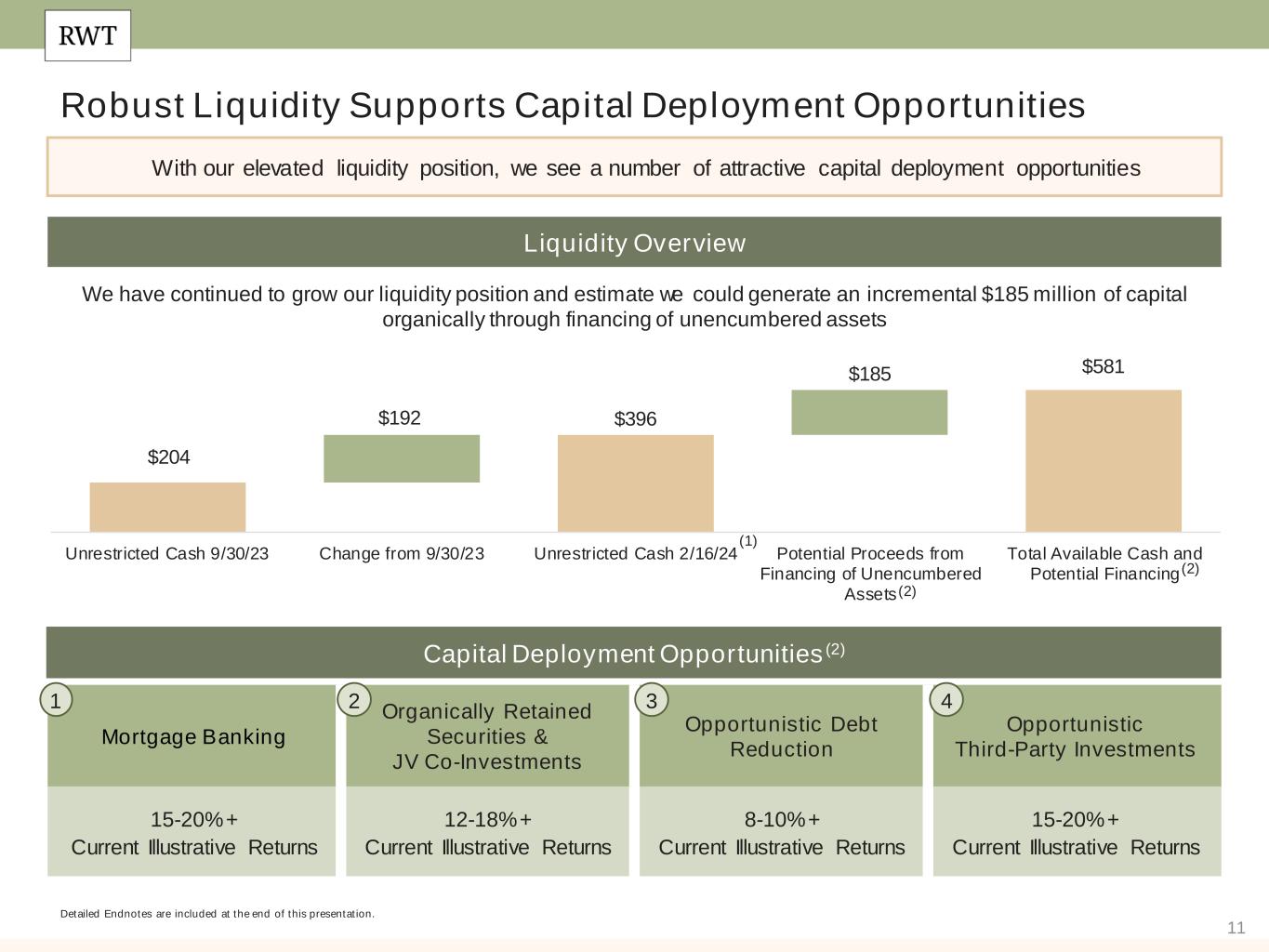
11 Robust Liquidity Supports Capital Deployment Opportunities Detailed Endnotes are included at the end of this presentation. With our elevated liquidity position, we see a number of attractive capital deployment opportunities $204 $192 $396 $185 $581 Unrestricted Cash 9/30/23 Change from 9/30/23 Unrestricted Cash 2/16/24 Potential Proceeds from Financing of Unencumbered Assets Total Available Cash and Potential Financing We have continued to grow our liquidity position and estimate we could generate an incremental $185 million of capital organically through financing of unencumbered assets Liquidity Overview Capital Deployment Opportunities(2) Mortgage Banking Organically Retained Securities & JV Co-Investments Opportunistic Debt Reduction Opportunistic Third-Party Investments 15-20%+ Current Illustrative Returns 12-18%+ Current Illustrative Returns 8-10%+ Current Illustrative Returns 15-20%+ Current Illustrative Returns (1) (2) 1 2 3 4 (2)
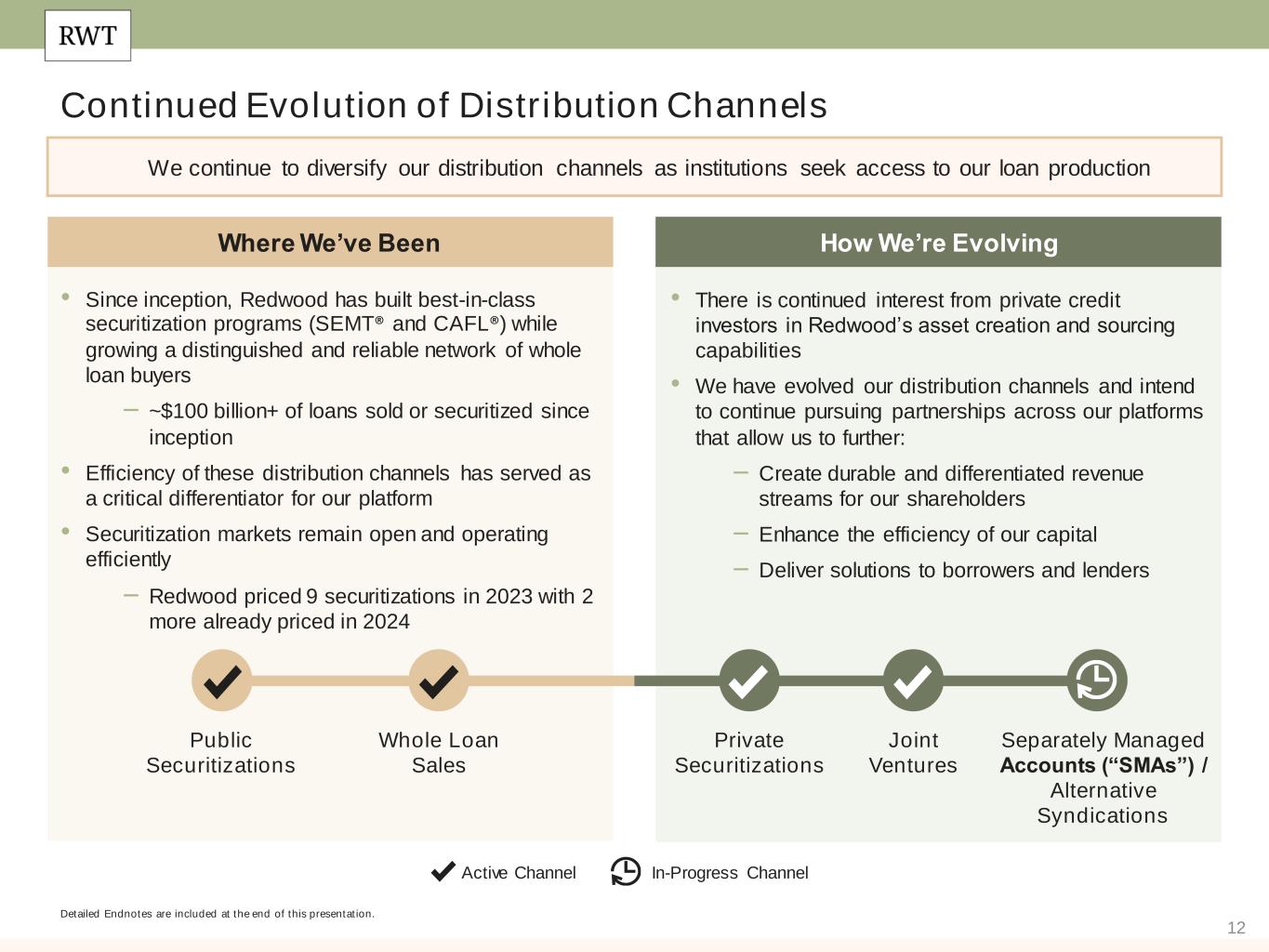
12 Continued Evolution of Distribution Channels Detailed Endnotes are included at the end of this presentation. We continue to diversify our distribution channels as institutions seek access to our loan production • Since inception, Redwood has built best-in-class securitization programs (SEMT® and CAFL®) while growing a distinguished and reliable network of whole loan buyers – ~$100 billion+ of loans sold or securitized since inception • Efficiency of these distribution channels has served as a critical differentiator for our platform • Securitization markets remain open and operating efficiently – Redwood priced 9 securitizations in 2023 with 2 more already priced in 2024 Where We’ve Been How We’re Evolving • There is continued interest from private credit investors in Redwood’s asset creation and sourcing capabilities • We have evolved our distribution channels and intend to continue pursuing partnerships across our platforms that allow us to further: – Create durable and differentiated revenue streams for our shareholders – Enhance the efficiency of our capital – Deliver solutions to borrowers and lenders Active Channel In-Progress Channel Public Securitizations Whole Loan Sales Private Securitizations Joint Ventures Separately Managed Accounts (“SMAs”) / Alternative Syndications
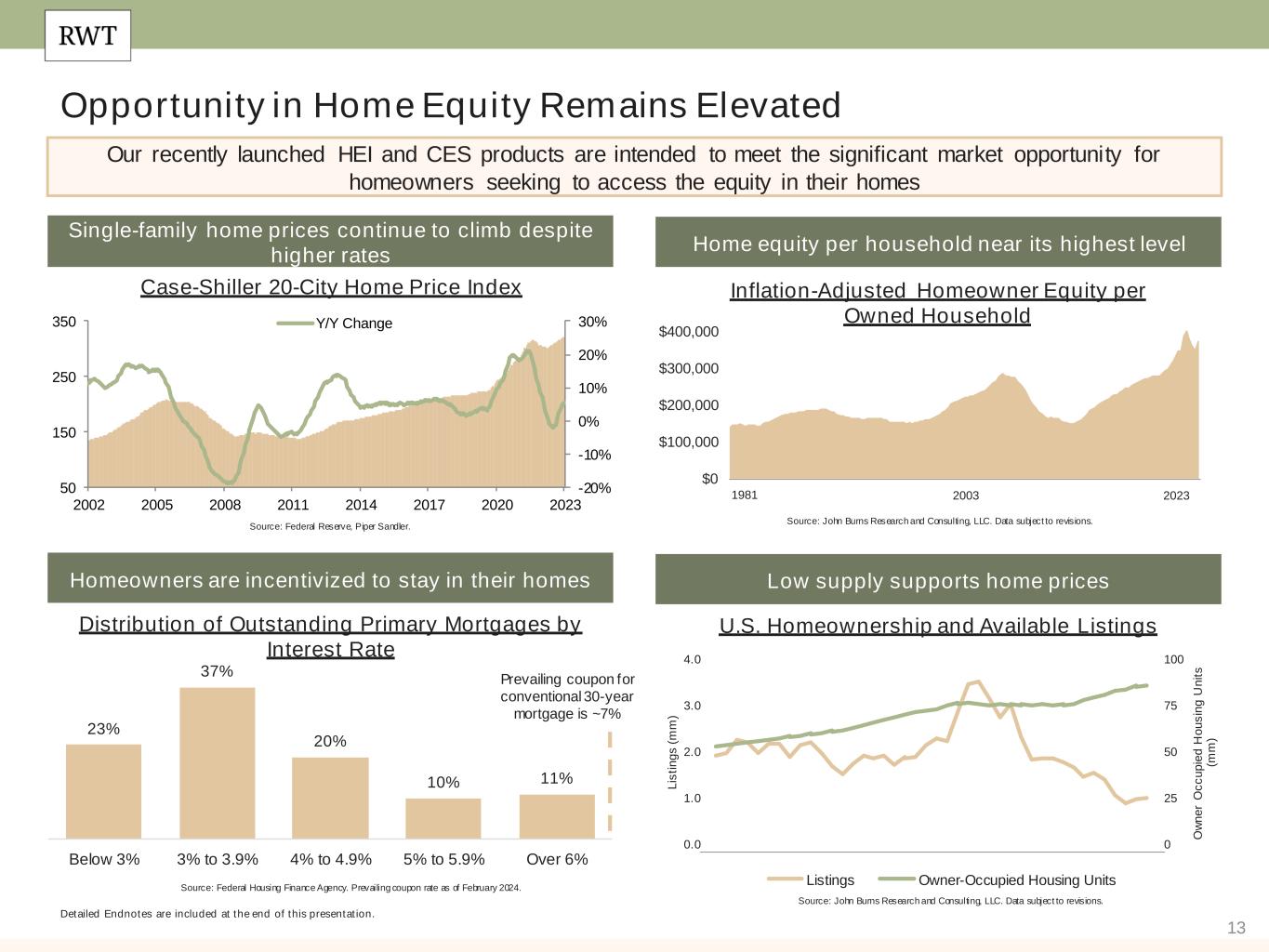
13 0 25 50 75 100 0.0 1.0 2.0 3.0 4.0 O w n e r O c c u p ie d H o u s in g U n it s (m m ) L is ti n g s ( m m ) Listings Owner-Occupied Housing Units Opportunity in Home Equity Remains Elevated Detailed Endnotes are included at the end of this presentation. Our recently launched HEI and CES products are intended to meet the significant market opportunity for homeowners seeking to access the equity in their homes -20% -10% 0% 10% 20% 30% 50 150 250 350 2002 2005 2008 2011 2014 2017 2020 2023 Y/Y Change Source: Federal Reserve, Piper Sandler. Single-family home prices continue to climb despite higher rates Home equity per household near its highest level Homeowners are incentivized to stay in their homes Case-Shiller 20-City Home Price Index Low supply supports home prices Inflation-Adjusted Homeowner Equity per Owned Household Distribution of Outstanding Primary Mortgages by Interest Rate U.S. Homeownership and Available Listings $0 $100,000 $200,000 $300,000 $400,000 23% 37% 20% 10% 11% Below 3% 3% to 3.9% 4% to 4.9% 5% to 5.9% Over 6% Source: John Burns Research and Consulting, LLC. Data subject to revisions. Prevailing coupon for conventional 30-year mortgage is ~7% Source: John Burns Research and Consulting, LLC. Data subject to revisions. 1981 20232003 Source: Federal Housing Finance Agency. Prevailing coupon rate as of February 2024.

14 Operating Businesses & Investment Portfolio
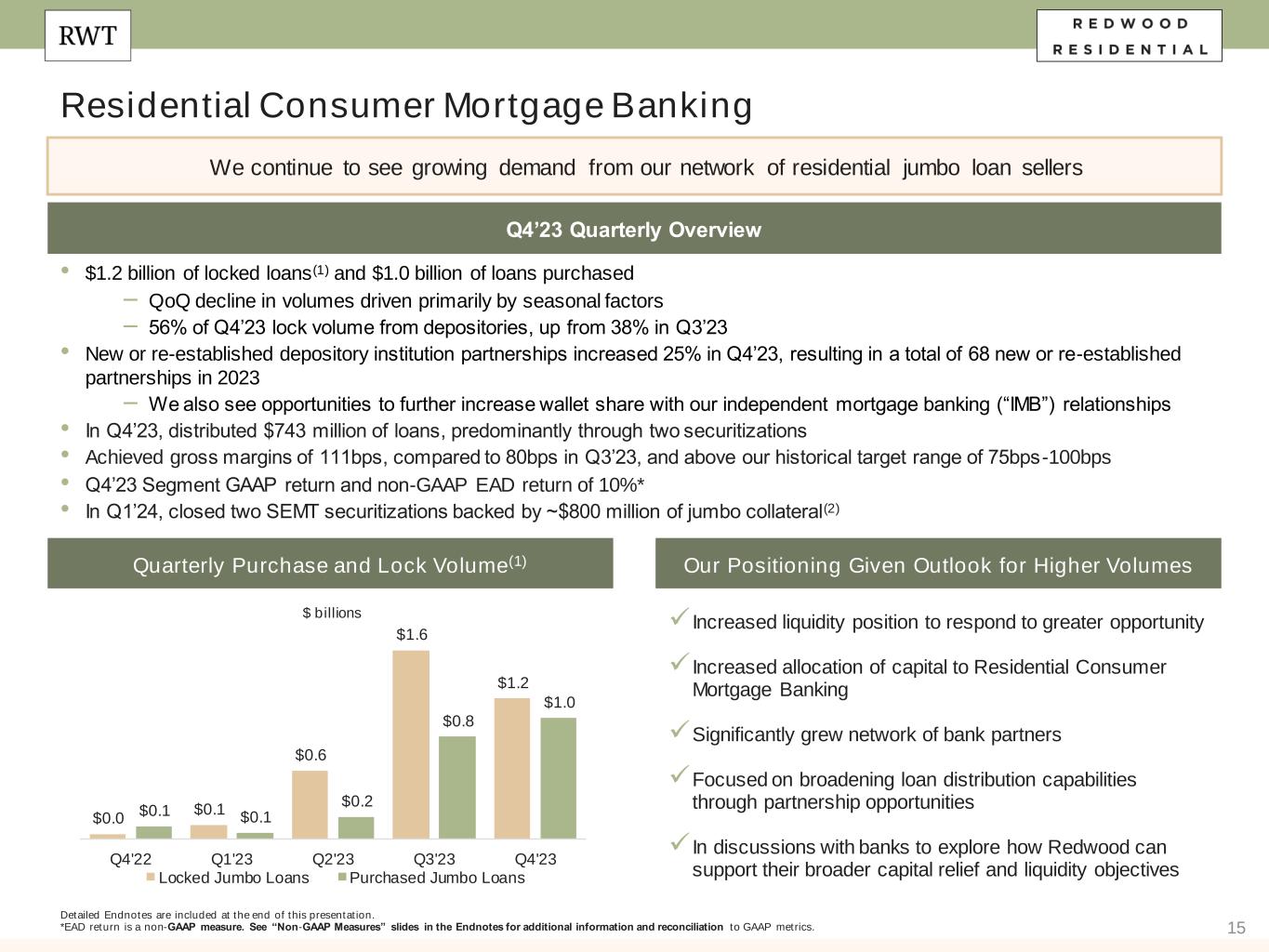
15 • $1.2 billion of locked loans(1) and $1.0 billion of loans purchased – QoQ decline in volumes driven primarily by seasonal factors – 56% of Q4’23 lock volume from depositories, up from 38% in Q3’23 • New or re-established depository institution partnerships increased 25% in Q4’23, resulting in a total of 68 new or re-established partnerships in 2023 – We also see opportunities to further increase wallet share with our independent mortgage banking (“IMB”) relationships • In Q4’23, distributed $743 million of loans, predominantly through two securitizations • Achieved gross margins of 111bps, compared to 80bps in Q3’23, and above our historical target range of 75bps-100bps • Q4’23 Segment GAAP return and non-GAAP EAD return of 10%* • In Q1’24, closed two SEMT securitizations backed by ~$800 million of jumbo collateral(2) Residential Consumer Mortgage Banking Q4’23 Quarterly Overview We continue to see growing demand from our network of residential jumbo loan sellers Detailed Endnotes are included at the end of this presentation. *EAD return is a non-GAAP measure. See “Non-GAAP Measures” slides in the Endnotes for additional information and reconciliation to GAAP metrics. $0.0 $0.1 $0.6 $1.6 $1.2 $0.1 $0.1 $0.2 $0.8 $1.0 Q4'22 Q1'23 Q2'23 Q3'23 Q4'23 Locked Jumbo Loans Purchased Jumbo Loans $ billions Quarterly Purchase and Lock Volume(1) Our Positioning Given Outlook for Higher Volumes ✓ Increased liquidity position to respond to greater opportunity ✓ Increased allocation of capital to Residential Consumer Mortgage Banking ✓Significantly grew network of bank partners ✓Focused on broadening loan distribution capabilities through partnership opportunities ✓ In discussions with banks to explore how Redwood can support their broader capital relief and liquidity objectives
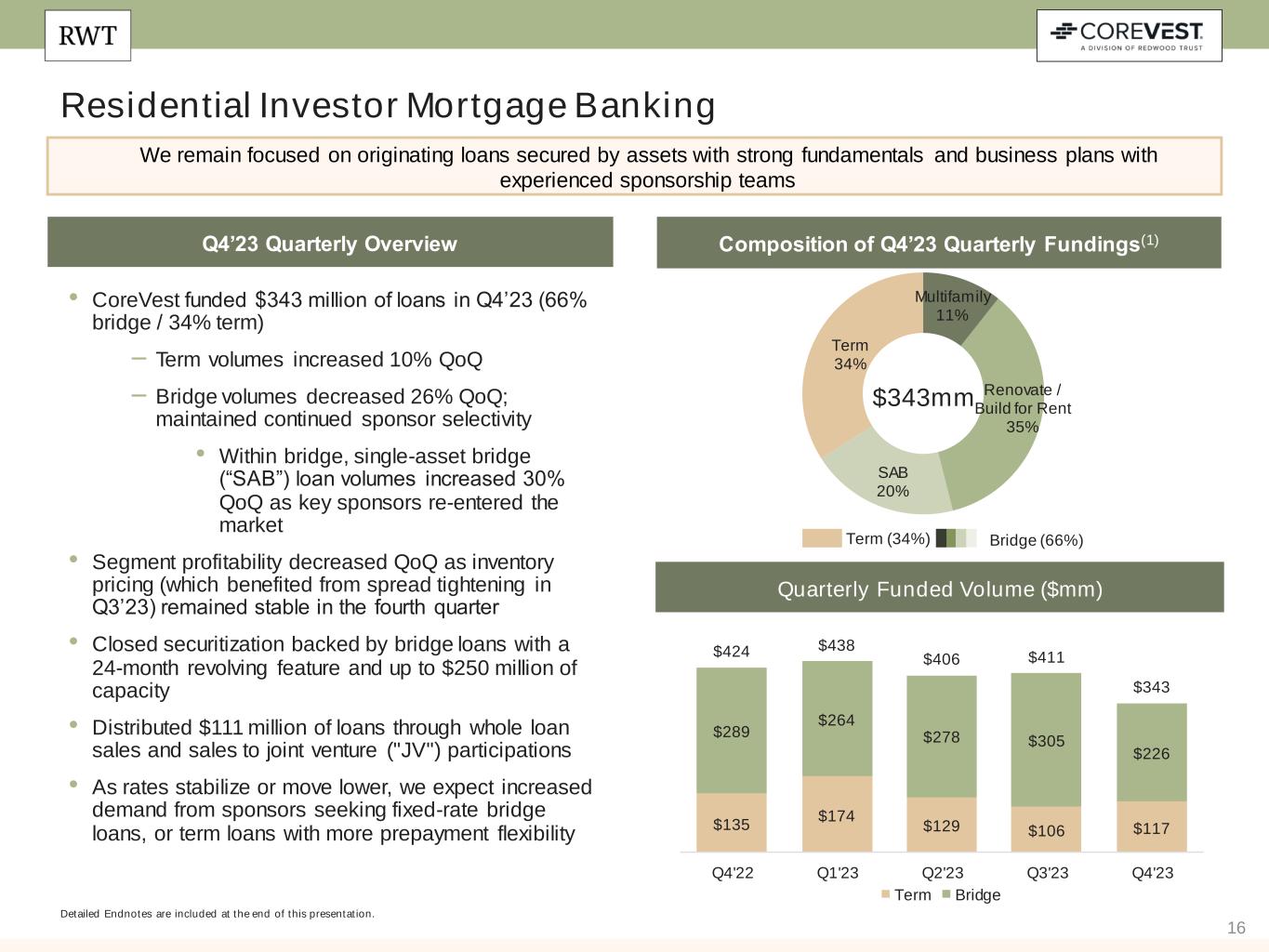
16 Residential Investor Mortgage Banking Q4’23 Quarterly Overview Composition of Q4’23 Quarterly Fundings(1) Detailed Endnotes are included at the end of this presentation. We remain focused on originating loans secured by assets with strong fundamentals and business plans with experienced sponsorship teams Term (34%) Bridge (66%) $343mm $135 $174 $129 $106 $117 $289 $264 $278 $305 $226 $424 $438 $406 $411 $343 Q4'22 Q1'23 Q2'23 Q3'23 Q4'23 Term Bridge Quarterly Funded Volume ($mm) • CoreVest funded $343 million of loans in Q4’23 (66% bridge / 34% term) – Term volumes increased 10% QoQ – Bridge volumes decreased 26% QoQ; maintained continued sponsor selectivity • Within bridge, single-asset bridge (“SAB”) loan volumes increased 30% QoQ as key sponsors re-entered the market • Segment profitability decreased QoQ as inventory pricing (which benefited from spread tightening in Q3’23) remained stable in the fourth quarter • Closed securitization backed by bridge loans with a 24-month revolving feature and up to $250 million of capacity • Distributed $111 million of loans through whole loan sales and sales to joint venture ("JV") participations • As rates stabilize or move lower, we expect increased demand from sponsors seeking fixed-rate bridge loans, or term loans with more prepayment flexibility Multifamily 11% Renovate / Build for Rent 35% SAB 20% Term 34%
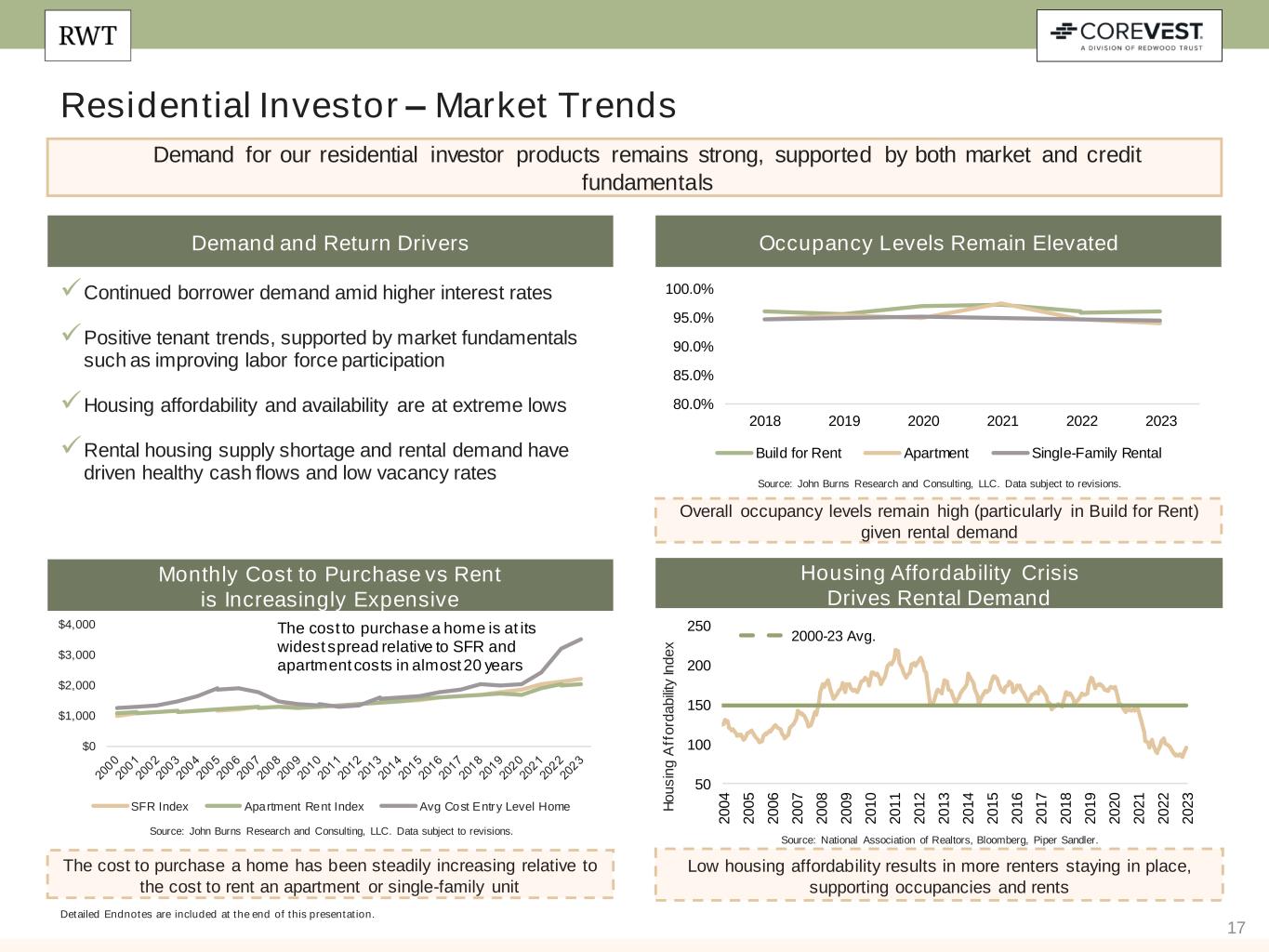
17 Residential Investor – Market Trends Detailed Endnotes are included at the end of this presentation. Demand for our residential investor products remains strong, supported by both market and credit fundamentals Demand and Return Drivers Housing Affordability Crisis Drives Rental Demand Occupancy Levels Remain Elevated Monthly Cost to Purchase vs Rent is Increasingly Expensive Overall occupancy levels remain high (particularly in Build for Rent) given rental demand Low housing affordability results in more renters staying in place, supporting occupancies and rents The cost to purchase a home has been steadily increasing relative to the cost to rent an apartment or single-family unit H o u s in g A ff o rd a b ili ty In d e x The cost to purchase a home is at its widest spread relative to SFR and apartment costs in almost 20 years Source: John Burns Research and Consulting, LLC. Data subject to revisions. Source: John Burns Research and Consulting, LLC. Data subject to revisions. Source: National Association of Realtors, Bloomberg, Piper Sandler. 50 100 150 200 250 2 0 0 4 2 0 0 5 2 0 0 6 2 0 0 7 2 0 0 8 2 0 0 9 2 0 1 0 2 0 1 1 2 0 1 2 2 0 1 3 2 0 1 4 2 0 1 5 2 0 1 6 2 0 1 7 2 0 1 8 2 0 1 9 2 0 2 0 2 0 2 1 2 0 2 2 2 0 2 3 2000-23 Avg. ✓Continued borrower demand amid higher interest rates ✓Positive tenant trends, supported by market fundamentals such as improving labor force participation ✓Housing affordability and availability are at extreme lows ✓Rental housing supply shortage and rental demand have driven healthy cash flows and low vacancy rates 80.0% 85.0% 90.0% 95.0% 100.0% 2018 2019 2020 2021 2022 2023 Build for Rent Apartment Single-Family Rental $0 $1,000 $2,000 $3,000 $4,000 SFR Index Apartment Rent Index Avg Cost Entry Level Home
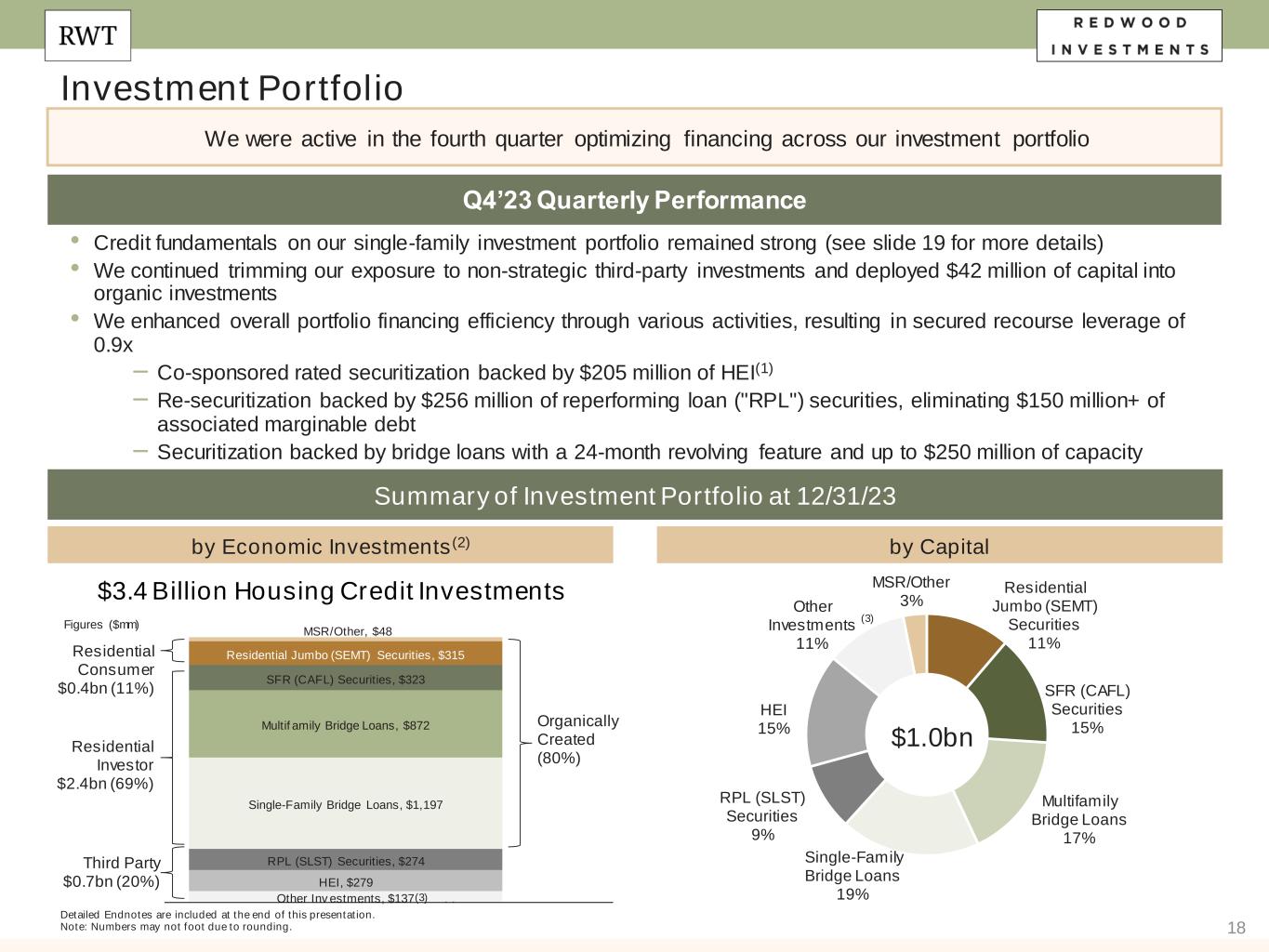
18 Investment Portfolio Q4’23 Quarterly Performance $3.4 Billion Housing Credit Investments Organically Created (80%) Detailed Endnotes are included at the end of this presentation. Note: Numbers may not foot due to rounding. We were active in the fourth quarter optimizing financing across our investment portfolio $1.0bn Third Party $0.7bn (20%) Residential Investor $2.4bn (69%) Residential Consumer $0.4bn (11%) Figures ($mm) Summary of Investment Portfolio at 12/31/23 by Economic Investments(2) by Capital (2) • Credit fundamentals on our single-family investment portfolio remained strong (see slide 19 for more details) • We continued trimming our exposure to non-strategic third-party investments and deployed $42 million of capital into organic investments • We enhanced overall portfolio financing efficiency through various activities, resulting in secured recourse leverage of 0.9x – Co-sponsored rated securitization backed by $205 million of HEI(1) – Re-securitization backed by $256 million of reperforming loan ("RPL") securities, eliminating $150 million+ of associated marginable debt – Securitization backed by bridge loans with a 24-month revolving feature and up to $250 million of capacity Residential Jumbo (SEMT) Securities 11% SFR (CAFL) Securities 15% Multifamily Bridge Loans 17% Single-Family Bridge Loans 19% RPL (SLST) Securities 9% HEI 15% Other Investments 11% MSR/Other 3% (3) (3) Other Inv estments, $137 HEI, $279 RPL (SLST) Securities, $274 Single-Family Bridge Loans, $1,197 Multif amily Bridge Loans, $872 SFR (CAFL) Securities, $323 Residential Jumbo (SEMT) Securities, $315 MSR/Other, $48
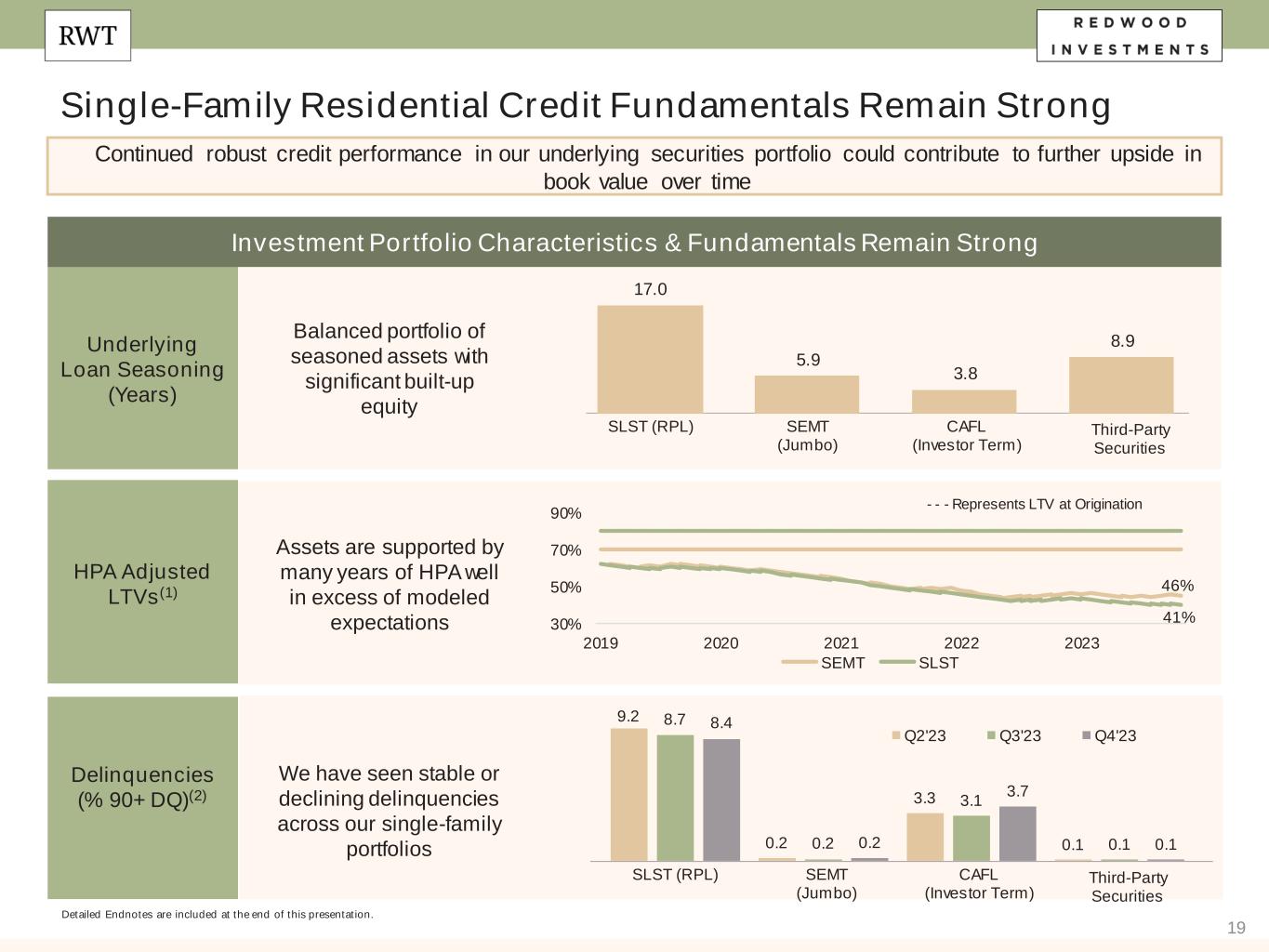
19 Single-Family Residential Credit Fundamentals Remain Strong Detailed Endnotes are included at the end of this presentation. Continued robust credit performance in our underlying securities portfolio could contribute to further upside in book value over time Underlying Loan Seasoning (Years) HPA Adjusted LTVs(1) Delinquencies (% 90+ DQ)(2) Balanced portfolio of seasoned assets with significant built-up equity SLST (RPL) SEMT (Jumbo) CAFL (Investor Term) Third-Party Securities 46% 41%30% 50% 70% 90% 2019 2020 2021 2022 2023 SEMT SLST - - - Represents LTV at Origination Assets are supported by many years of HPA well in excess of modeled expectations We have seen stable or declining delinquencies across our single-family portfolios Investment Portfolio Characteristics & Fundamentals Remain Strong SLST (RPL) SEMT (Jumbo) CAFL (Investor Term) Third-Party Securities 17.0 5.9 3.8 8.9 9.2 0.2 3.3 0.1 8.7 0.2 3.1 0.1 8.4 0.2 3.7 0.1 Q2'23 Q3'23 Q4'23
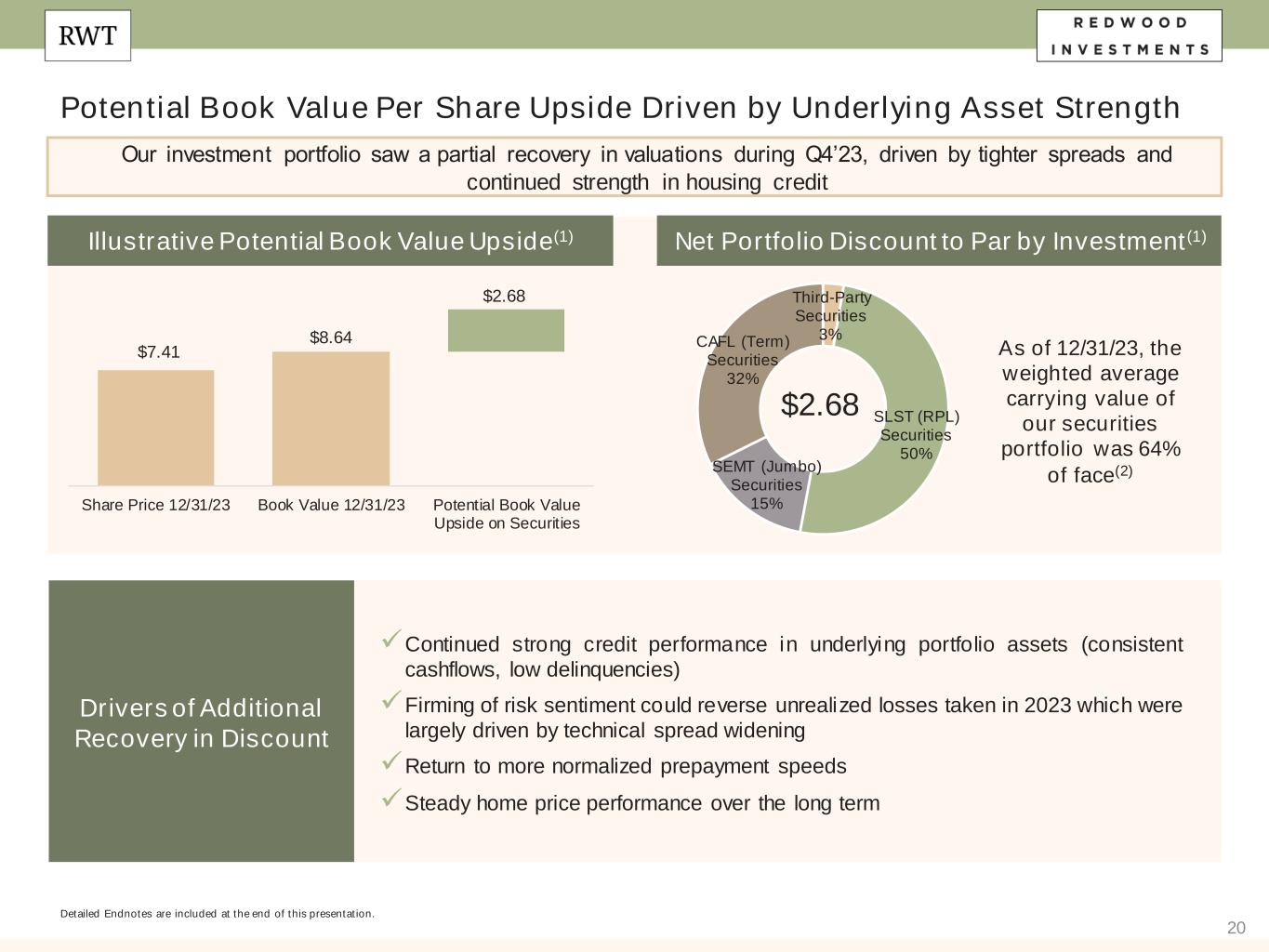
20 Potential Book Value Per Share Upside Driven by Underlying Asset Strength Detailed Endnotes are included at the end of this presentation. Our investment portfolio saw a partial recovery in valuations during Q4’23, driven by tighter spreads and continued strength in housing credit Drivers of Additional Recovery in Discount ✓Continued strong credit performance in underlying portfolio assets (consistent cashflows, low delinquencies) ✓Firming of risk sentiment could reverse unrealized losses taken in 2023 which were largely driven by technical spread widening ✓Return to more normalized prepayment speeds ✓Steady home price performance over the long term $7.41 $8.64 $2.68 Share Price 12/31/23 Book Value 12/31/23 Potential Book Value Upside on Securities Net Portfolio Discount to Par by Investment(1)Illustrative Potential Book Value Upside(1) As of 12/31/23, the weighted average carrying value of our securities portfolio was 64% of face(2) Third-Party Securities 3% SLST (RPL) Securities 50% SEMT (Jumbo) Securities 15% CAFL (Term) Securities 32% $2.68
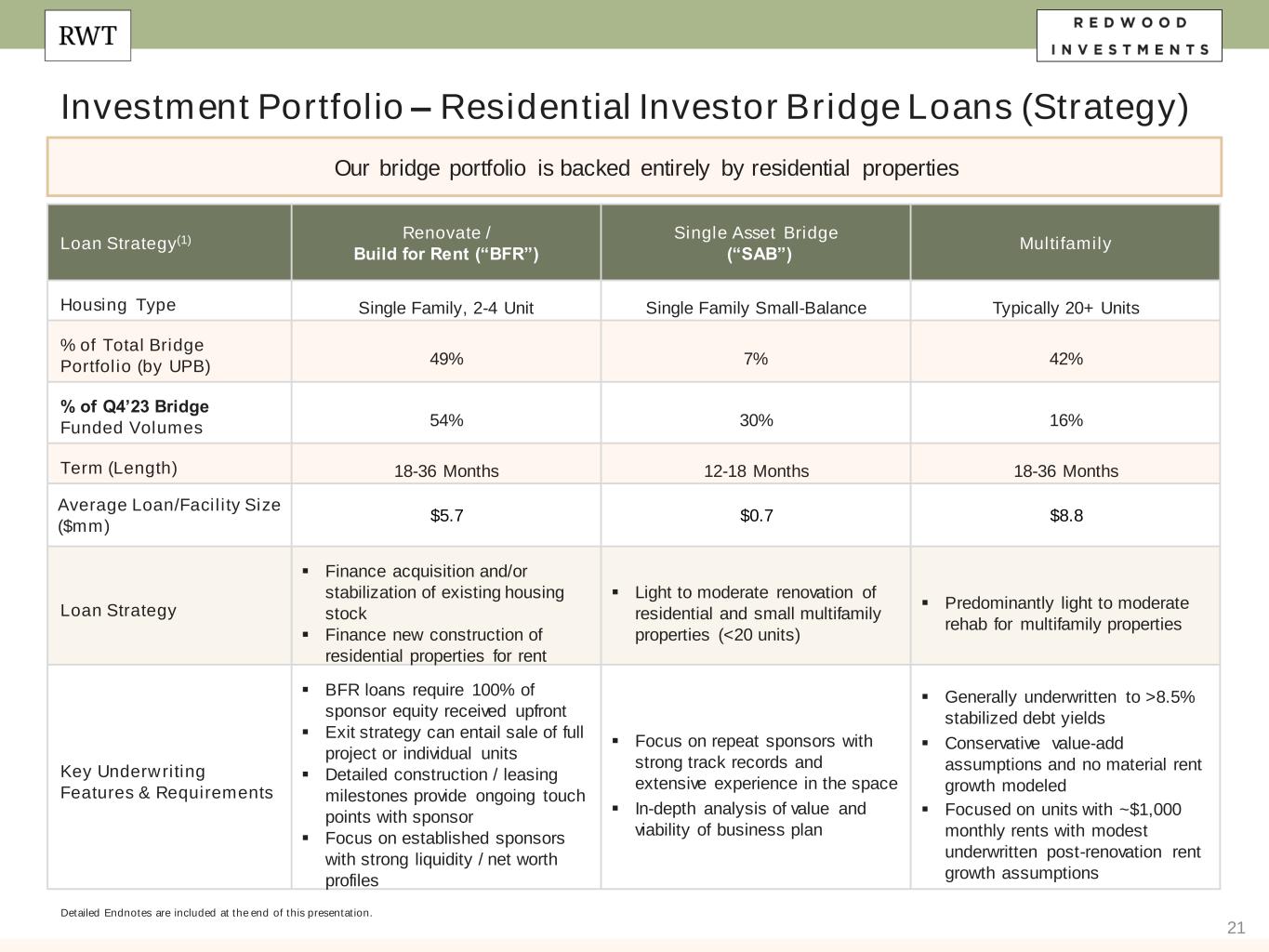
21 Investment Portfolio – Residential Investor Bridge Loans (Strategy) Our bridge portfolio is backed entirely by residential properties Detailed Endnotes are included at the end of this presentation. Loan Strategy(1) Renovate / Build for Rent (“BFR”) Single Asset Bridge (“SAB”) Multifamily Housing Type Single Family, 2-4 Unit Single Family Small-Balance Typically 20+ Units % of Total Bridge Portfolio (by UPB) 49% 7% 42% % of Q4’23 Bridge Funded Volumes 54% 30% 16% Term (Length) 18-36 Months 12-18 Months 18-36 Months Average Loan/Facility Size ($mm) $5.7 $0.7 $8.8 Loan Strategy ▪ Finance acquisition and/or stabilization of existing housing stock ▪ Finance new construction of residential properties for rent ▪ Light to moderate renovation of residential and small multifamily properties (<20 units) ▪ Predominantly light to moderate rehab for multifamily properties Key Underwriting Features & Requirements ▪ BFR loans require 100% of sponsor equity received upfront ▪ Exit strategy can entail sale of full project or individual units ▪ Detailed construction / leasing milestones provide ongoing touch points with sponsor ▪ Focus on established sponsors with strong liquidity / net worth profiles ▪ Focus on repeat sponsors with strong track records and extensive experience in the space ▪ In-depth analysis of value and viability of business plan ▪ Generally underwritten to >8.5% stabilized debt yields ▪ Conservative value-add assumptions and no material rent growth modeled ▪ Focused on units with ~$1,000 monthly rents with modest underwritten post-renovation rent growth assumptions
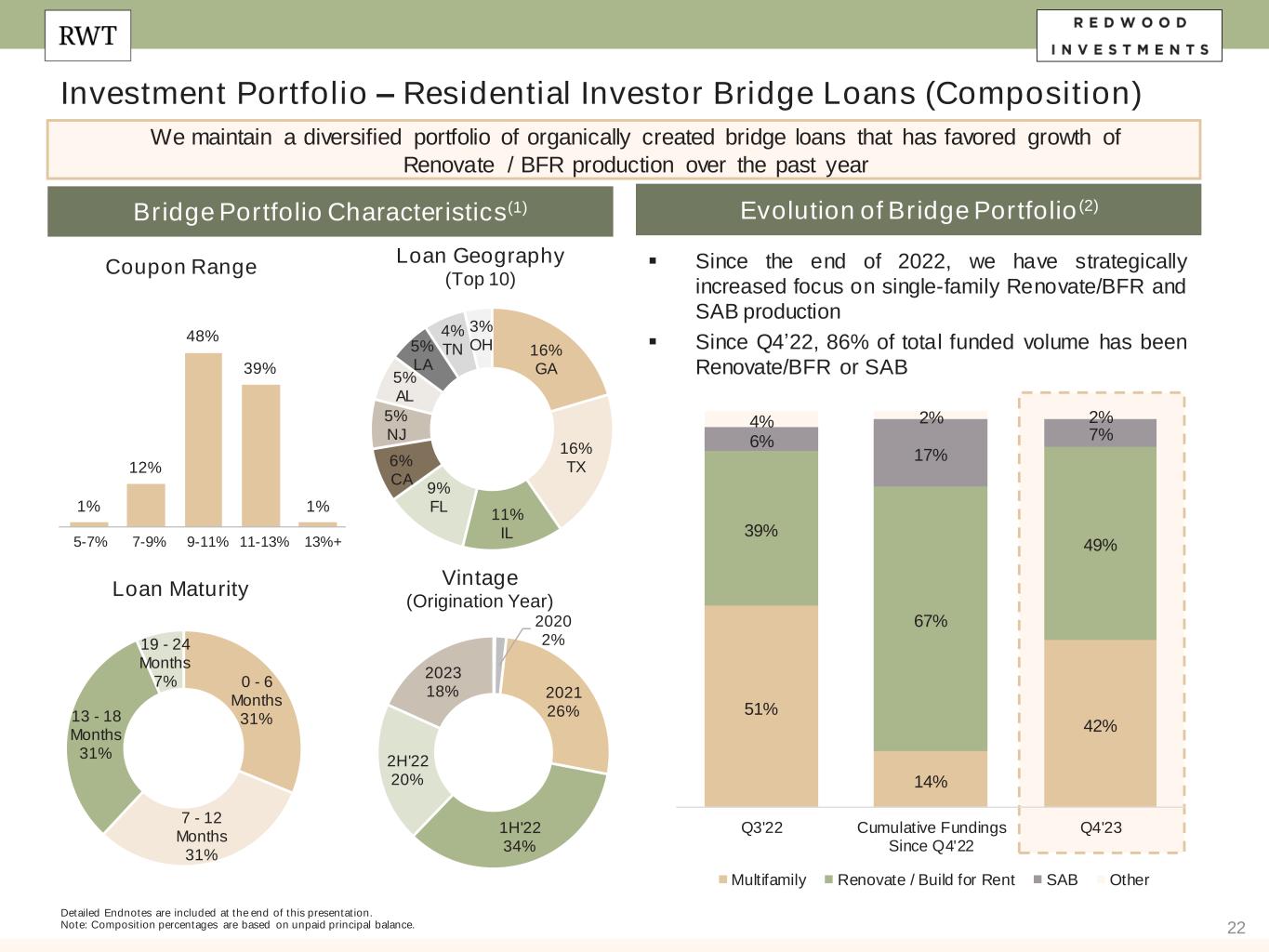
22 Investment Portfolio – Residential Investor Bridge Loans (Composition) Detailed Endnotes are included at the end of this presentation. Note: Composition percentages are based on unpaid principal balance. Bridge Portfolio Characteristics(1) Coupon Range Loan Geography (Top 10) Vintage (Origination Year) Loan Maturity Evolution of Bridge Portfolio(2) ▪ Since the end of 2022, we have strategically increased focus on single-family Renovate/BFR and SAB production ▪ Since Q4’22, 86% of total funded volume has been Renovate/BFR or SAB 0 - 6 Months 31% 7 - 12 Months 31% 13 - 18 Months 31% 19 - 24 Months 7% 2020 2% 2021 26% 1H'22 34% 2H'22 20% 2023 18% 16% GA 16% TX 11% IL 9% FL 6% CA 5% NJ 5% AL 5% LA 4% TN 3% OH We maintain a diversified portfolio of organically created bridge loans that has favored growth of Renovate / BFR production over the past year 1% 12% 48% 39% 1% 5-7% 7-9% 9-11% 11-13% 13%+ 51% 14% 42% 39% 67% 49% 6% 17% 7% 4% 2% 2% Q3'22 Cumulative Fundings Since Q4'22 Q4'23 Multifamily Renovate / Build for Rent SAB Other
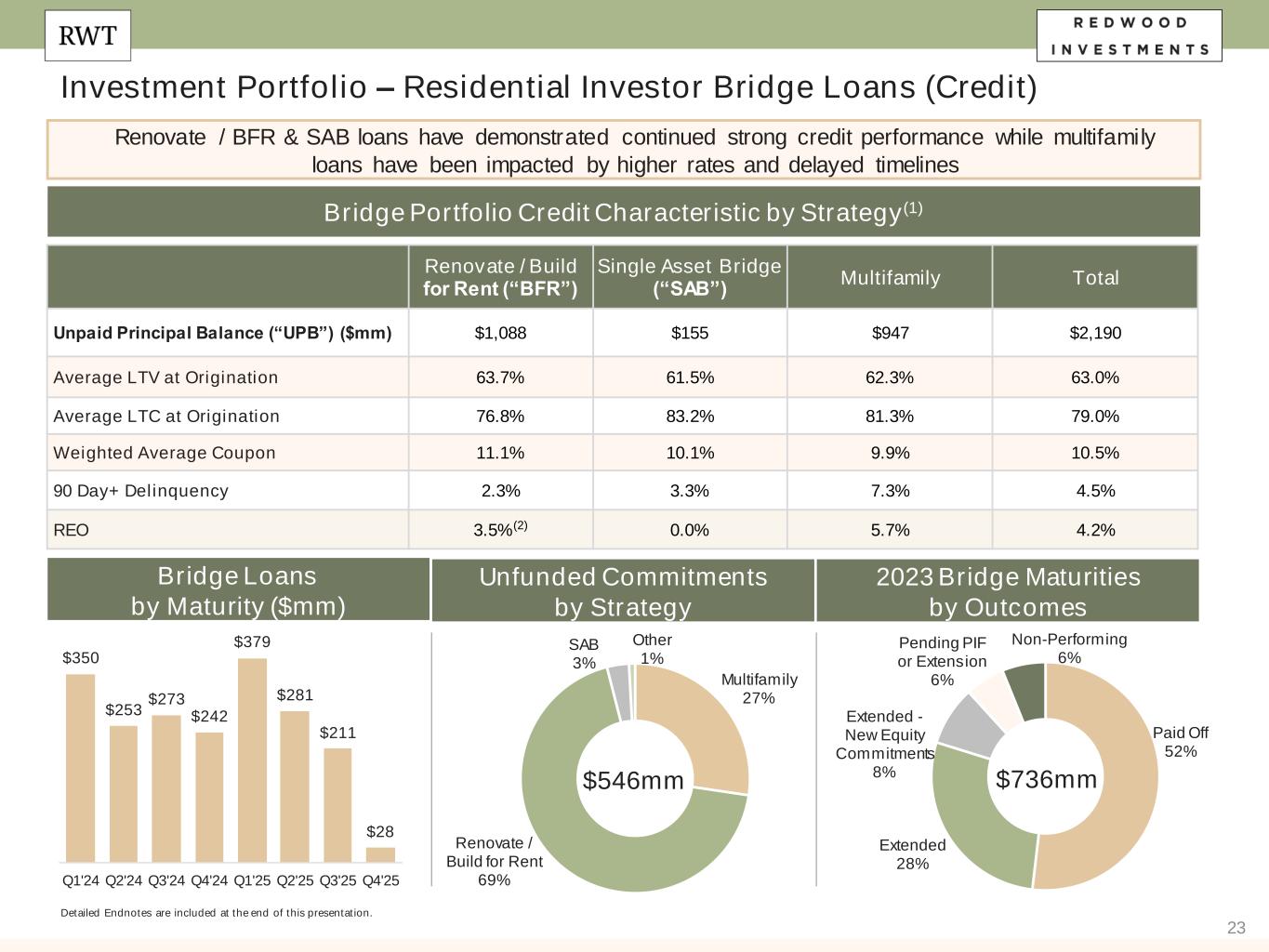
23 Investment Portfolio – Residential Investor Bridge Loans (Credit) Detailed Endnotes are included at the end of this presentation. Renovate / BFR & SAB loans have demonstrated continued strong credit performance while multifamily loans have been impacted by higher rates and delayed timelines Renovate / Build for Rent (“BFR”) Single Asset Bridge (“SAB”) Multifamily Total Unpaid Principal Balance (“UPB”) ($mm) $1,088 $155 $947 $2,190 Average LTV at Origination 63.7% 61.5% 62.3% 63.0% Average LTC at Origination 76.8% 83.2% 81.3% 79.0% Weighted Average Coupon 11.1% 10.1% 9.9% 10.5% 90 Day+ Delinquency 2.3% 3.3% 7.3% 4.5% REO 3.5%(2) 0.0% 5.7% 4.2% Bridge Portfolio Credit Characteristic by Strategy(1) Bridge Loans by Maturity ($mm) $350 $253 $273 $242 $379 $281 $211 $28 Q1'24 Q2'24 Q3'24 Q4'24 Q1'25 Q2'25 Q3'25 Q4'25 Unfunded Commitments by Strategy 2023 Bridge Maturities by Outcomes Paid Off 52% Extended 28% Extended - New Equity Commitments 8% Pending PIF or Extension 6% Non-Performing 6% Multifamily 27% Renovate / Build for Rent 69% SAB 3% Other 1% $546mm $736mm
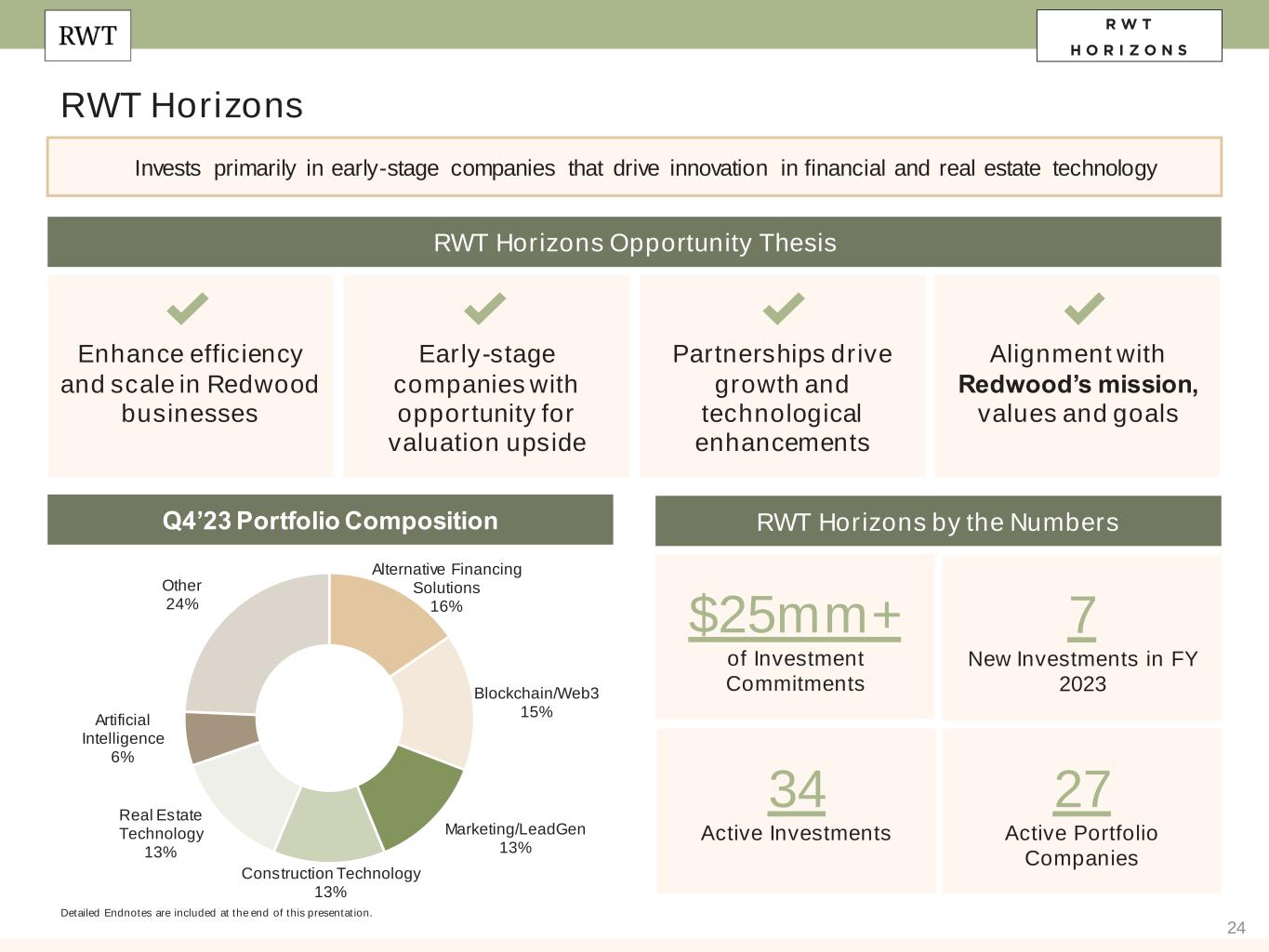
24 RWT Horizons Invests primarily in early-stage companies that drive innovation in financial and real estate technology RWT Horizons by the Numbers RWT Horizons Opportunity Thesis Enhance efficiency and scale in Redwood businesses Early-stage companies with opportunity for valuation upside Partnerships drive growth and technological enhancements Alignment with Redwood’s mission, values and goals 27 Active Portfolio Companies Q4’23 Portfolio Composition 7 New Investments in FY 2023 Alternative Financing Solutions 16% Blockchain/Web3 15% Marketing/LeadGen 13% Construction Technology 13% Real Estate Technology 13% Artificial Intelligence 6% Other 24% $25mm+ of Investment Commitments 34 Active Investments Detailed Endnotes are included at the end of this presentation.
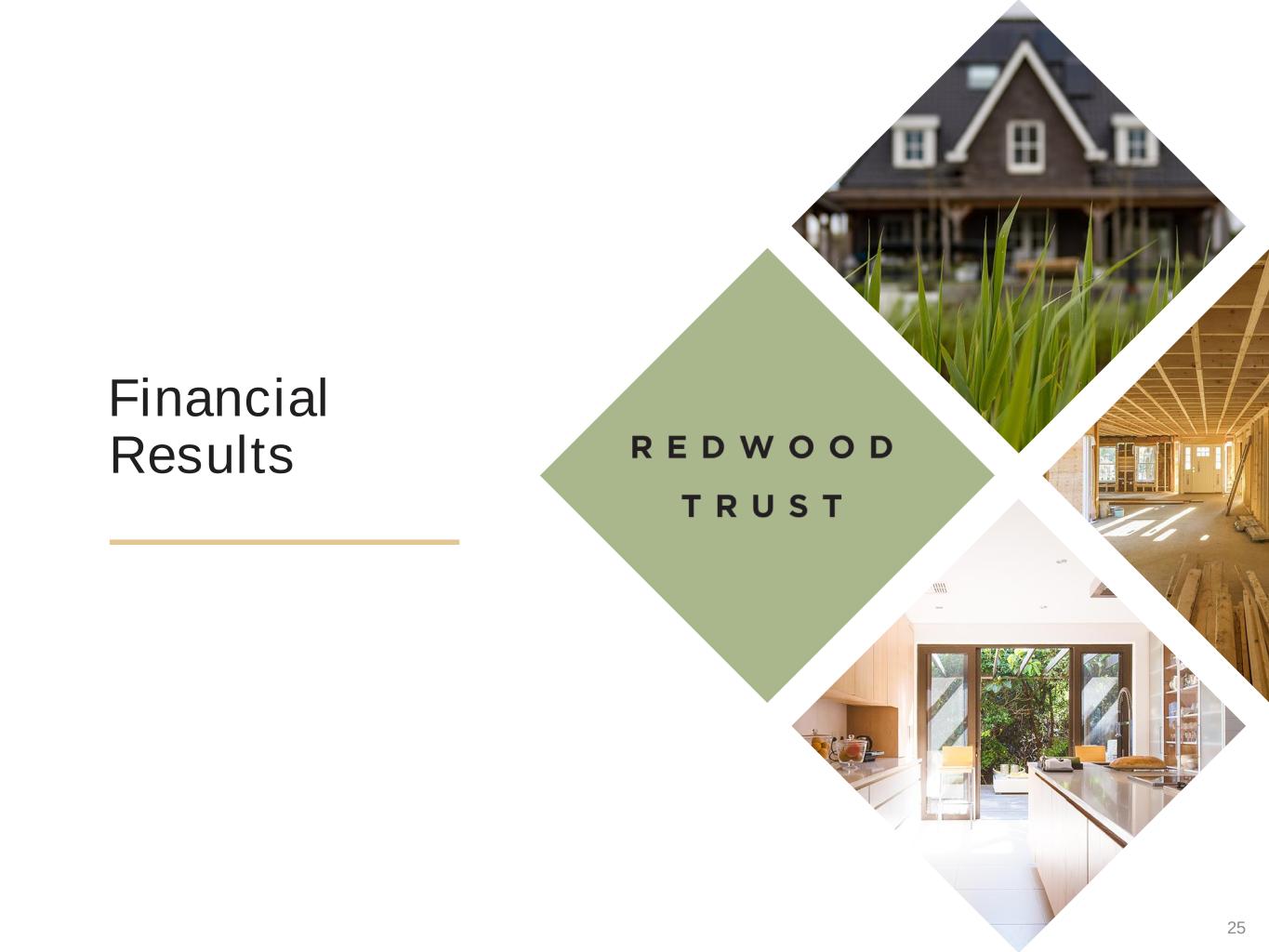
25 Financial Results
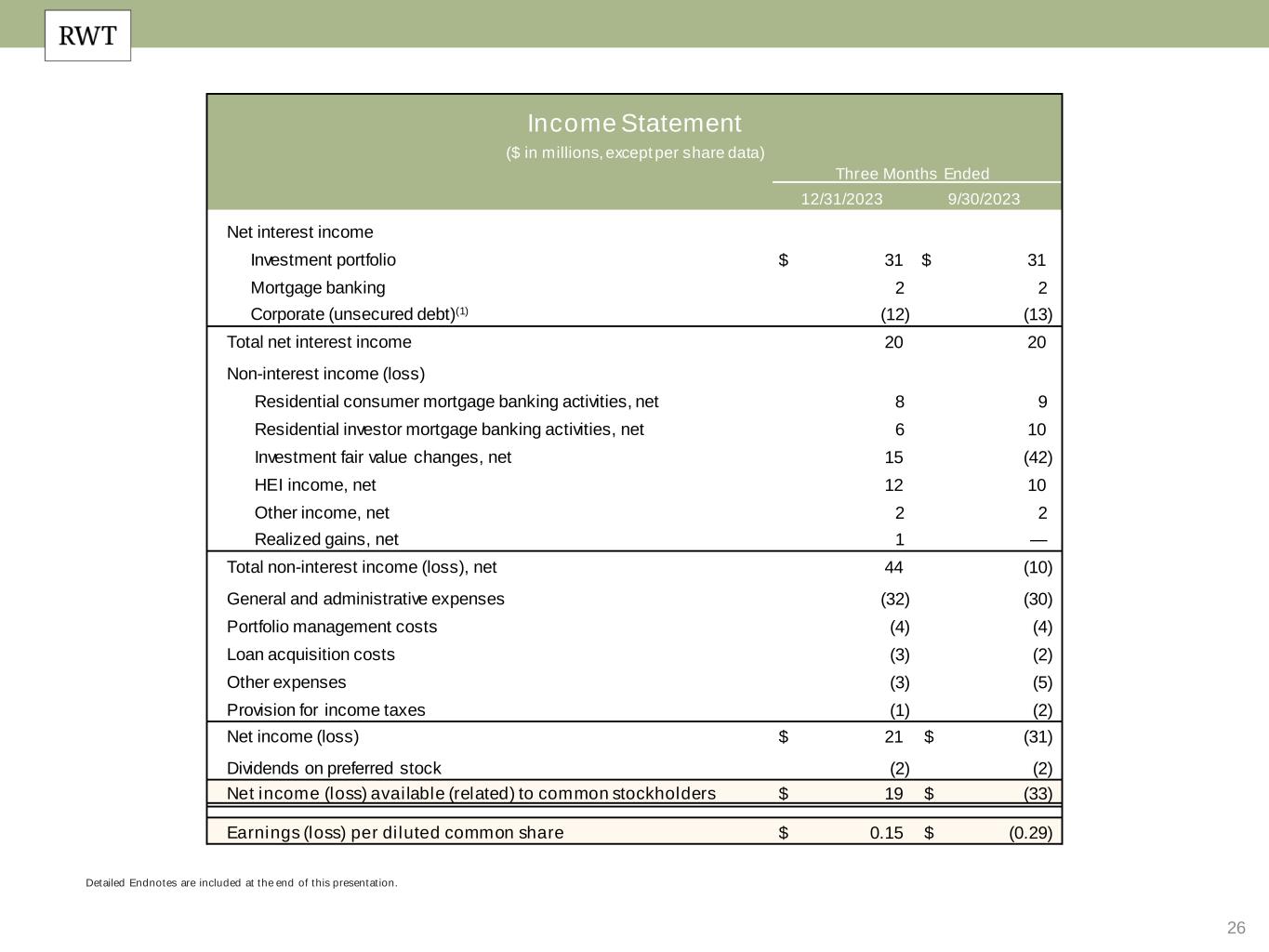
26 Detailed Endnotes are included at the end of this presentation. Income Statement ($ in millions, except per share data) Three Months Ended 12/31/2023 9/30/2023 Net interest income Investment portfolio $ 31 $ 31 Mortgage banking 2 2 Corporate (unsecured debt)(1) (12) (13) Total net interest income 20 20 Non-interest income (loss) Residential consumer mortgage banking activities, net 8 9 Residential investor mortgage banking activities, net 6 10 Investment fair value changes, net 15 (42) HEI income, net 12 10 Other income, net 2 2 Realized gains, net 1 — Total non-interest income (loss), net 44 (10) General and administrative expenses (32) (30) Portfolio management costs (4) (4) Loan acquisition costs (3) (2) Other expenses (3) (5) Provision for income taxes (1) (2) Net income (loss) $ 21 $ (31) Dividends on preferred stock (2) (2) Net income (loss) available (related) to common stockholders $ 19 $ (33) Earnings (loss) per diluted common share $ 0.15 $ (0.29)
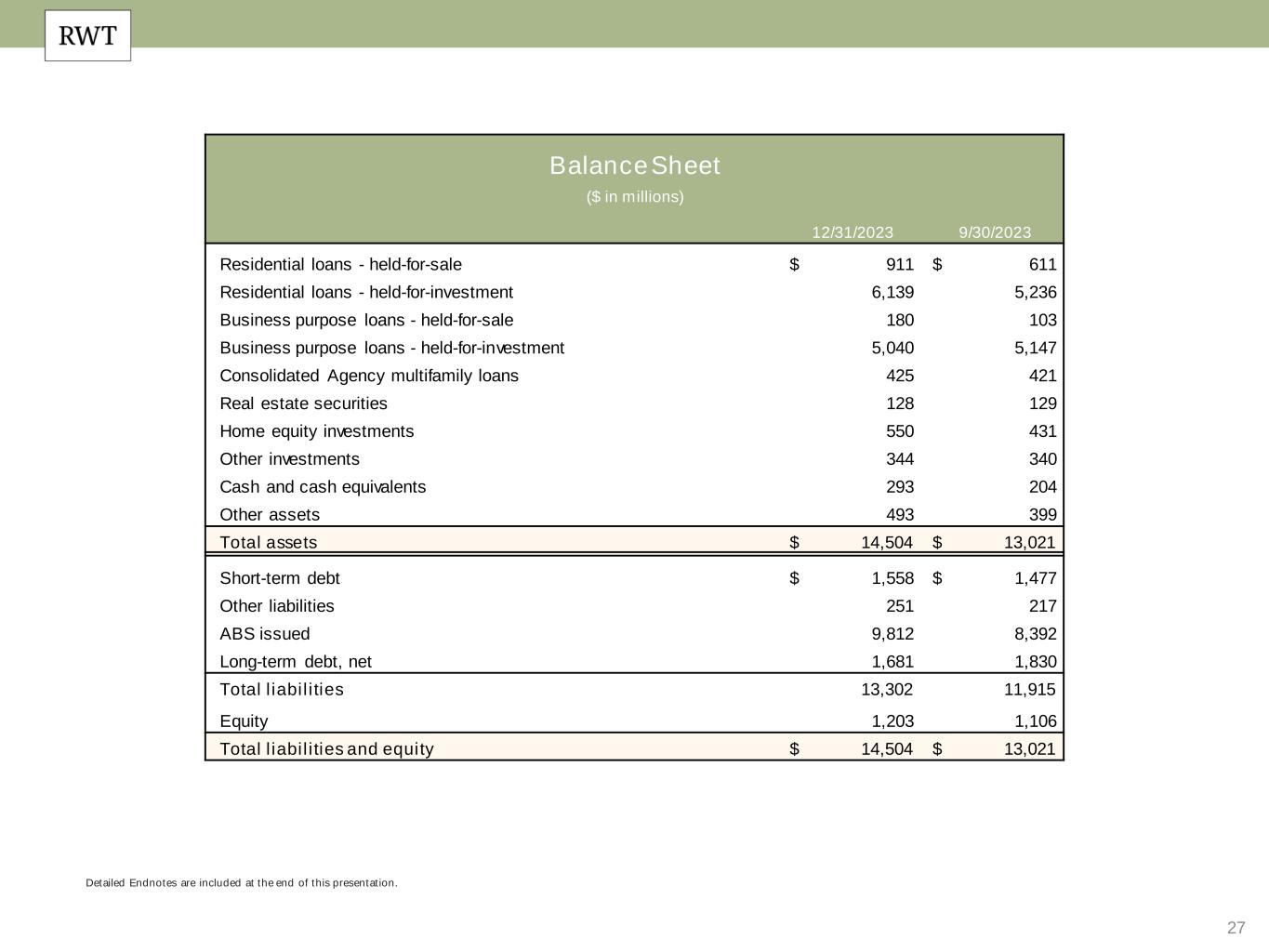
27 Detailed Endnotes are included at the end of this presentation. Balance Sheet ($ in millions) 12/31/2023 9/30/2023 Residential loans - held-for-sale $ 911 $ 611 Residential loans - held-for-investment 6,139 5,236 Business purpose loans - held-for-sale 180 103 Business purpose loans - held-for-investment 5,040 5,147 Consolidated Agency multifamily loans 425 421 Real estate securities 128 129 Home equity investments 550 431 Other investments 344 340 Cash and cash equivalents 293 204 Other assets 493 399 Total assets $ 14,504 $ 13,021 Short-term debt $ 1,558 $ 1,477 Other liabilities 251 217 ABS issued 9,812 8,392 Long-term debt, net 1,681 1,830 Total liabilities 13,302 11,915 Equity 1,203 1,106 Total liabilities and equity $ 14,504 $ 13,021
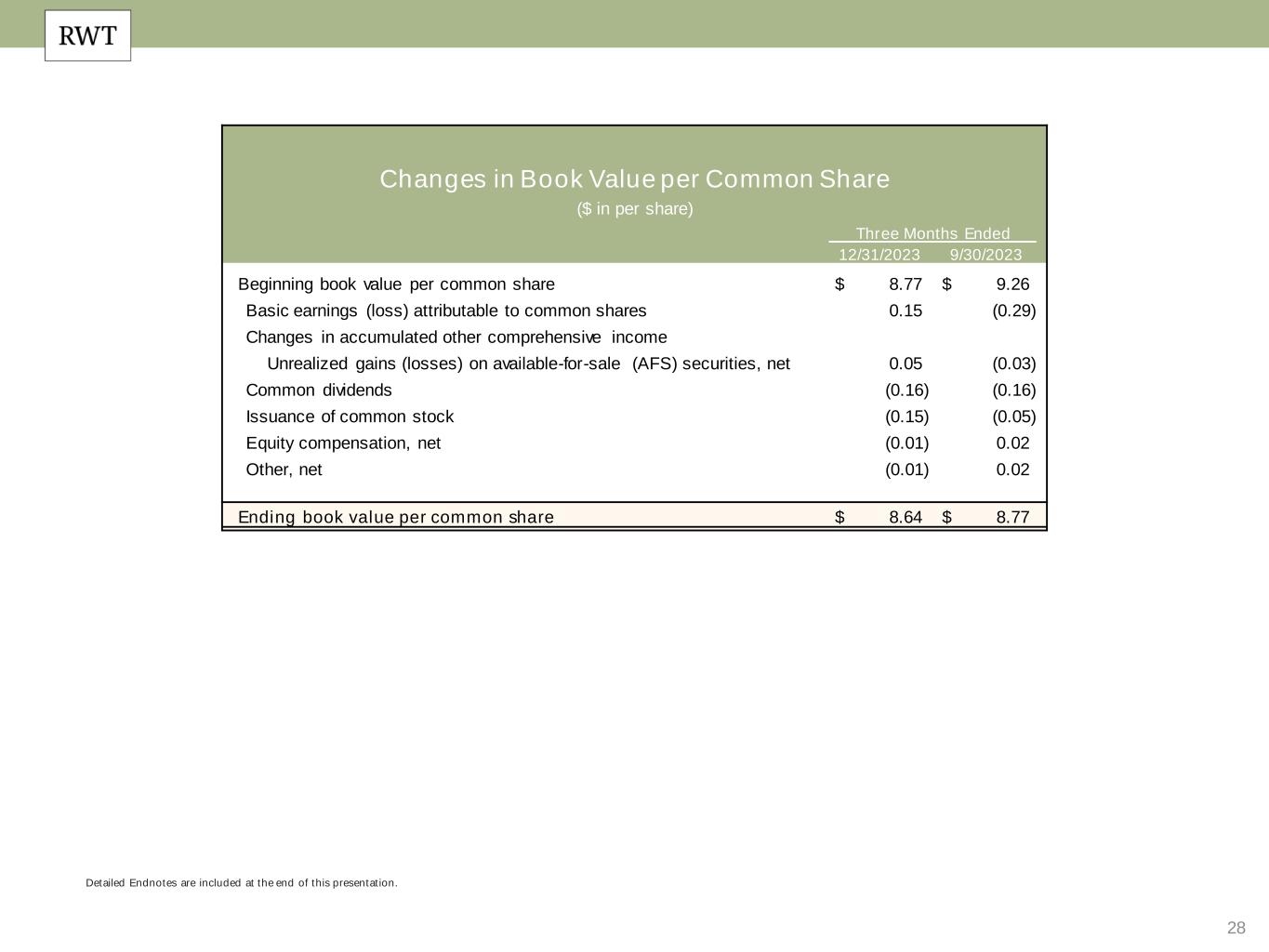
28 Detailed Endnotes are included at the end of this presentation. Changes in Book Value per Common Share ($ in per share) Three Months Ended 12/31/2023 9/30/2023 Beginning book value per common share $ 8.77 $ 9.26 Basic earnings (loss) attributable to common shares 0.15 (0.29) Changes in accumulated other comprehensive income Unrealized gains (losses) on available-for-sale (AFS) securities, net 0.05 (0.03) Common dividends (0.16) (0.16) Issuance of common stock (0.15) (0.05) Equity compensation, net (0.01) 0.02 Other, net (0.01) 0.02 Ending book value per common share $ 8.64 $ 8.77
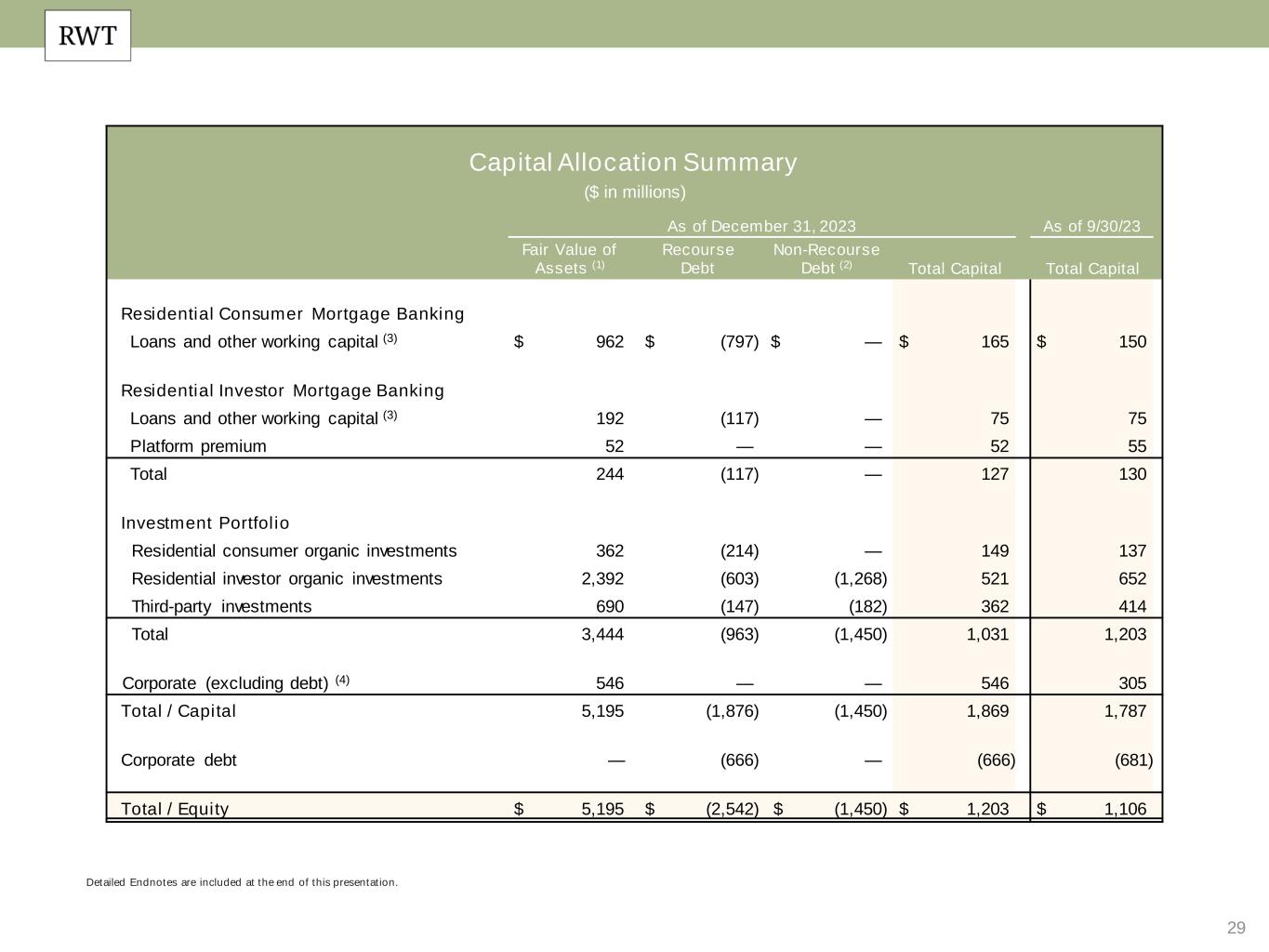
29 Detailed Endnotes are included at the end of this presentation. Capital Allocation Summary ($ in millions) As of December 31, 2023 As of 9/30/23 Fair Value of Assets (1) Recourse Debt Non-Recourse Debt (2) Total Capital Total Capital Residential Consumer Mortgage Banking Loans and other working capital (3) $ 962 $ (797) $ — $ 165 $ 150 Residential Investor Mortgage Banking Loans and other working capital (3) 192 (117) — 75 75 Platform premium 52 — — 52 55 Total 244 (117) — 127 130 Investment Portfolio Residential consumer organic investments 362 (214) — 149 137 Residential investor organic investments 2,392 (603) (1,268) 521 652 Third-party investments 690 (147) (182) 362 414 Total 3,444 (963) (1,450) 1,031 1,203 Corporate (excluding debt) (4) 546 — — 546 305 Total / Capital 5,195 (1,876) (1,450) 1,869 1,787 Corporate debt — (666) — (666) (681) Total / Equity $ 5,195 $ (2,542) $ (1,450) $ 1,203 $ 1,106
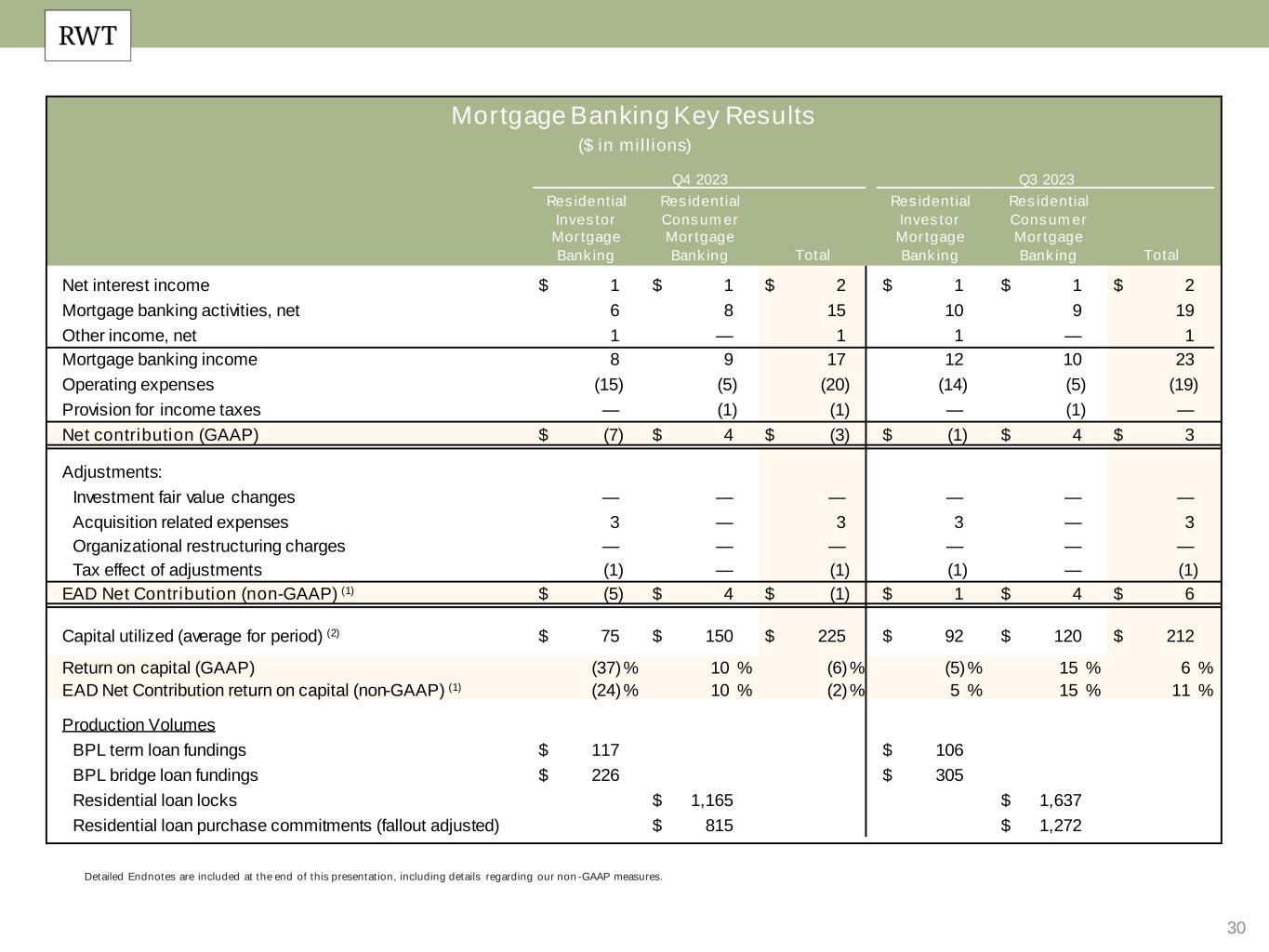
30 Detailed Endnotes are included at the end of this presentation, including details regarding our non-GAAP measures. Mortgage Banking Key Results ($ in millions) Q4 2023 Q3 2023 Residential Investor Mortgage Banking Residential Consumer Mortgage Banking Total Residential Investor Mortgage Banking Residential Consumer Mortgage Banking Total Net interest income $ 1 $ 1 $ 2 $ 1 $ 1 $ 2 Mortgage banking activities, net 6 8 15 10 9 19 Other income, net 1 — 1 1 — 1 Mortgage banking income 8 9 17 12 10 23 Operating expenses (15) (5) (20) (14) (5) (19) Provision for income taxes — (1) (1) — (1) — Net contribution (GAAP) $ (7) $ 4 $ (3) $ (1) $ 4 $ 3 Adjustments: Investment fair value changes — — — — — — Acquisition related expenses 3 — 3 3 — 3 Organizational restructuring charges — — — — — — Tax effect of adjustments (1) — (1) (1) — (1) EAD Net Contribution (non-GAAP) (1) $ (5) $ 4 $ (1) $ 1 $ 4 $ 6 Capital utilized (average for period) (2) $ 75 $ 150 $ 225 $ 92 $ 120 $ 212 Return on capital (GAAP) (37)% 10 % (6)% (5)% 15 % 6 % EAD Net Contribution return on capital (non-GAAP) (1) (24)% 10 % (2)% 5 % 15 % 11 % Production Volumes BPL term loan fundings $ 117 $ 106 BPL bridge loan fundings $ 226 $ 305 Residential loan locks $ 1,165 $ 1,637 Residential loan purchase commitments (fallout adjusted) $ 815 $ 1,272
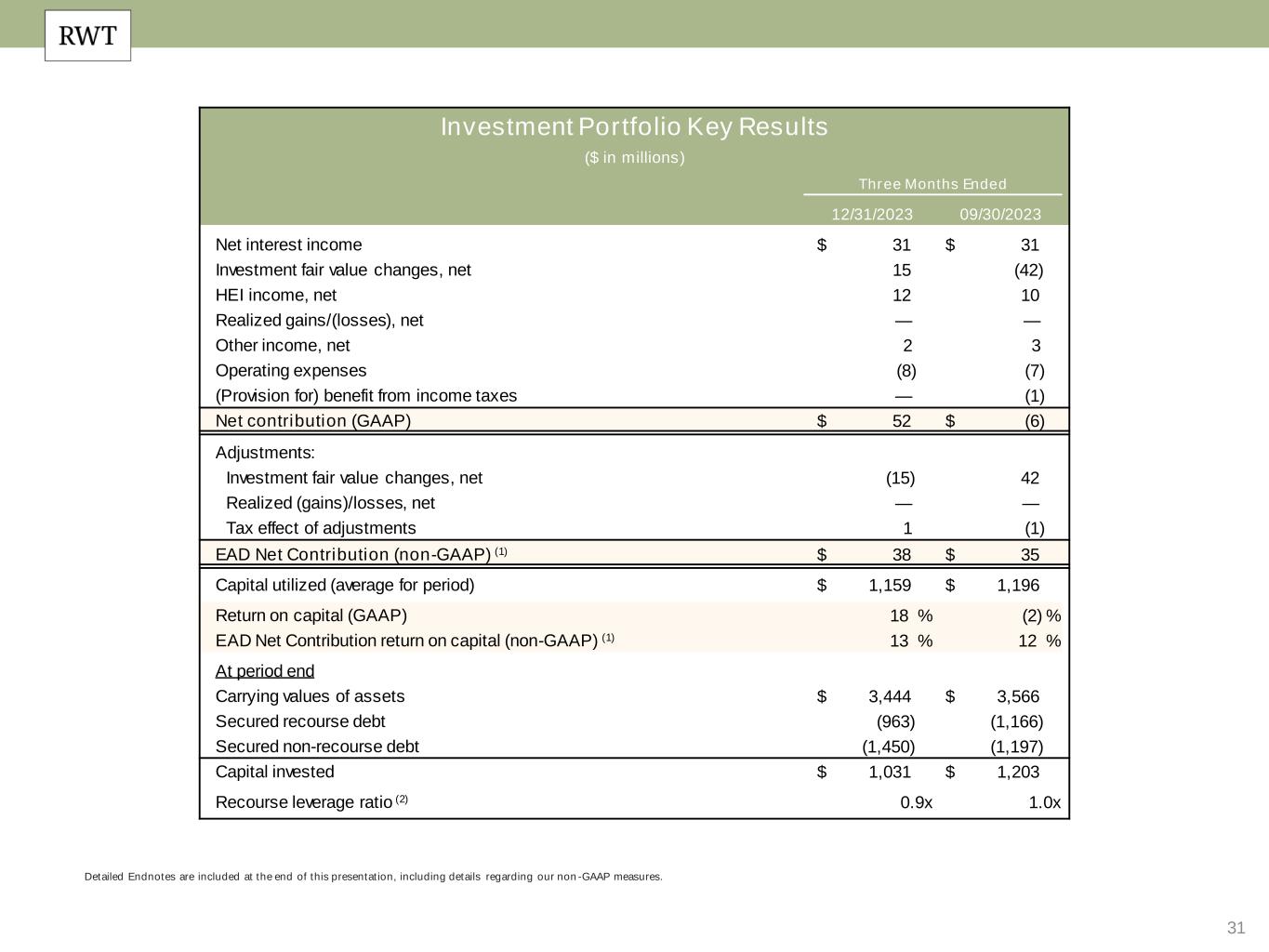
31 Detailed Endnotes are included at the end of this presentation, including details regarding our non-GAAP measures. Investment Portfolio Key Results ($ in millions) Three Months Ended 12/31/2023 09/30/2023 Net interest income $ 31 $ 31 Investment fair value changes, net 15 (42) HEI income, net 12 10 Realized gains/(losses), net — — Other income, net 2 3 Operating expenses (8) (7) (Provision for) benefit from income taxes — (1) Net contribution (GAAP) $ 52 $ (6) Adjustments: Investment fair value changes, net (15) 42 Realized (gains)/losses, net — — Tax effect of adjustments 1 (1) EAD Net Contribution (non-GAAP) (1) $ 38 $ 35 Capital utilized (average for period) $ 1,159 $ 1,196 Return on capital (GAAP) 18 % (2) % EAD Net Contribution return on capital (non-GAAP) (1) 13 % 12 % At period end Carrying values of assets $ 3,444 $ 3,566 Secured recourse debt (963) (1,166) Secured non-recourse debt (1,450) (1,197) Capital invested $ 1,031 $ 1,203 Recourse leverage ratio (2) 0.9x 1.0x
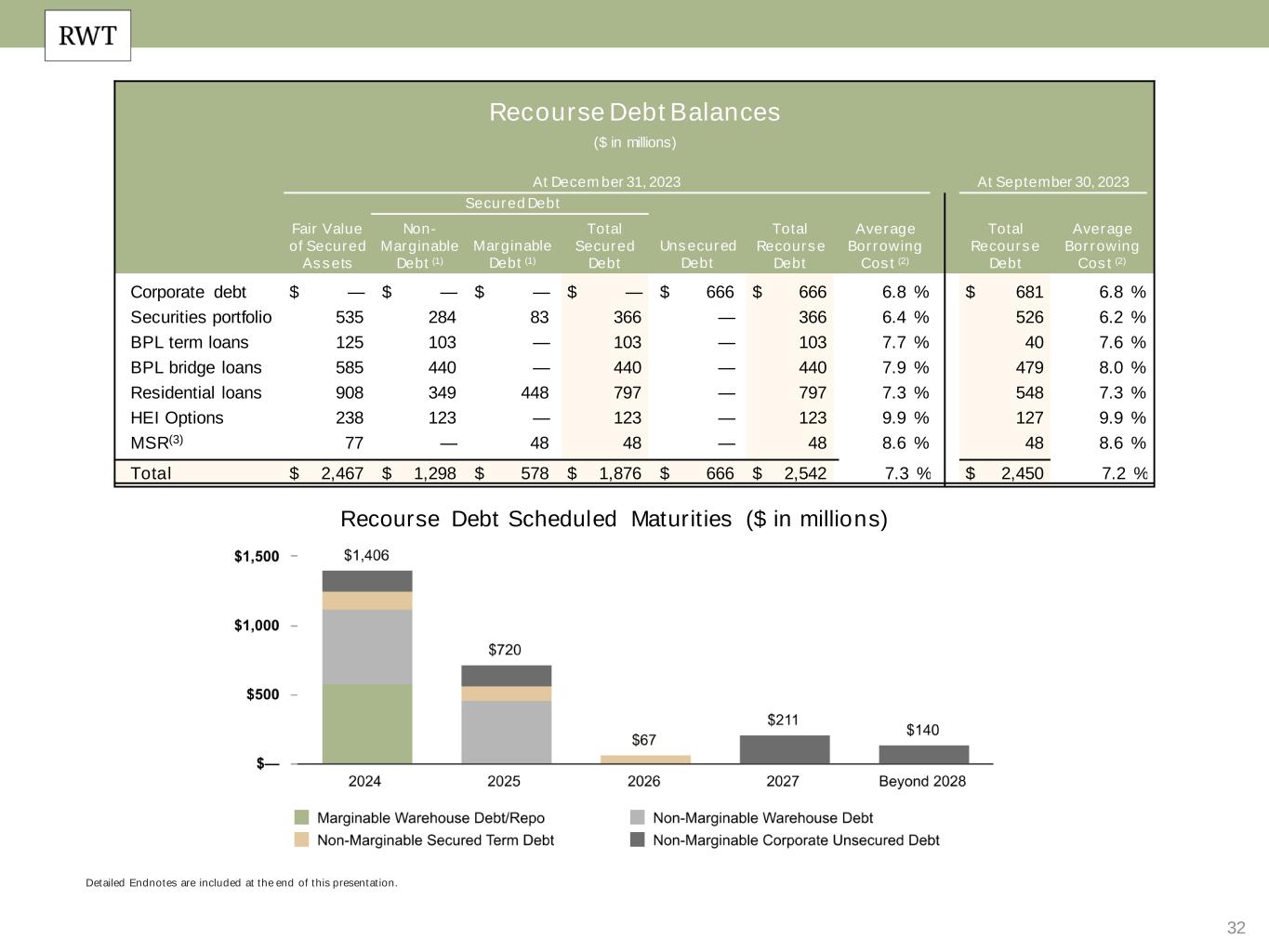
32 Detailed Endnotes are included at the end of this presentation. Recourse Debt Scheduled Maturities ($ in millions) Recourse Debt Balances ($ in millions) At December 31, 2023 At September 30, 2023 Secured Debt Fair Value of Secured Assets Non- Marginable Debt (1) Marginable Debt (1) Total Secured Debt Unsecured Debt Total Recourse Debt Average Borrowing Cost (2) Total Recourse Debt Average Borrowing Cost (2) Corporate debt $ — $ — $ — $ — $ 666 $ 666 6.8 % $ 681 6.8 % Securities portfolio 535 284 83 366 — 366 6.4 % 526 6.2 % BPL term loans 125 103 — 103 — 103 7.7 % 40 7.6 % BPL bridge loans 585 440 — 440 — 440 7.9 % 479 8.0 % Residential loans 908 349 448 797 — 797 7.3 % 548 7.3 % HEI Options 238 123 — 123 — 123 9.9 % 127 9.9 % MSR(3) 77 — 48 48 — 48 8.6 % 48 8.6 % Total $ 2,467 $ 1,298 $ 578 $ 1,876 $ 666 $ 2,542 7.3 % $ 2,450 7.2 %

33 Endnotes
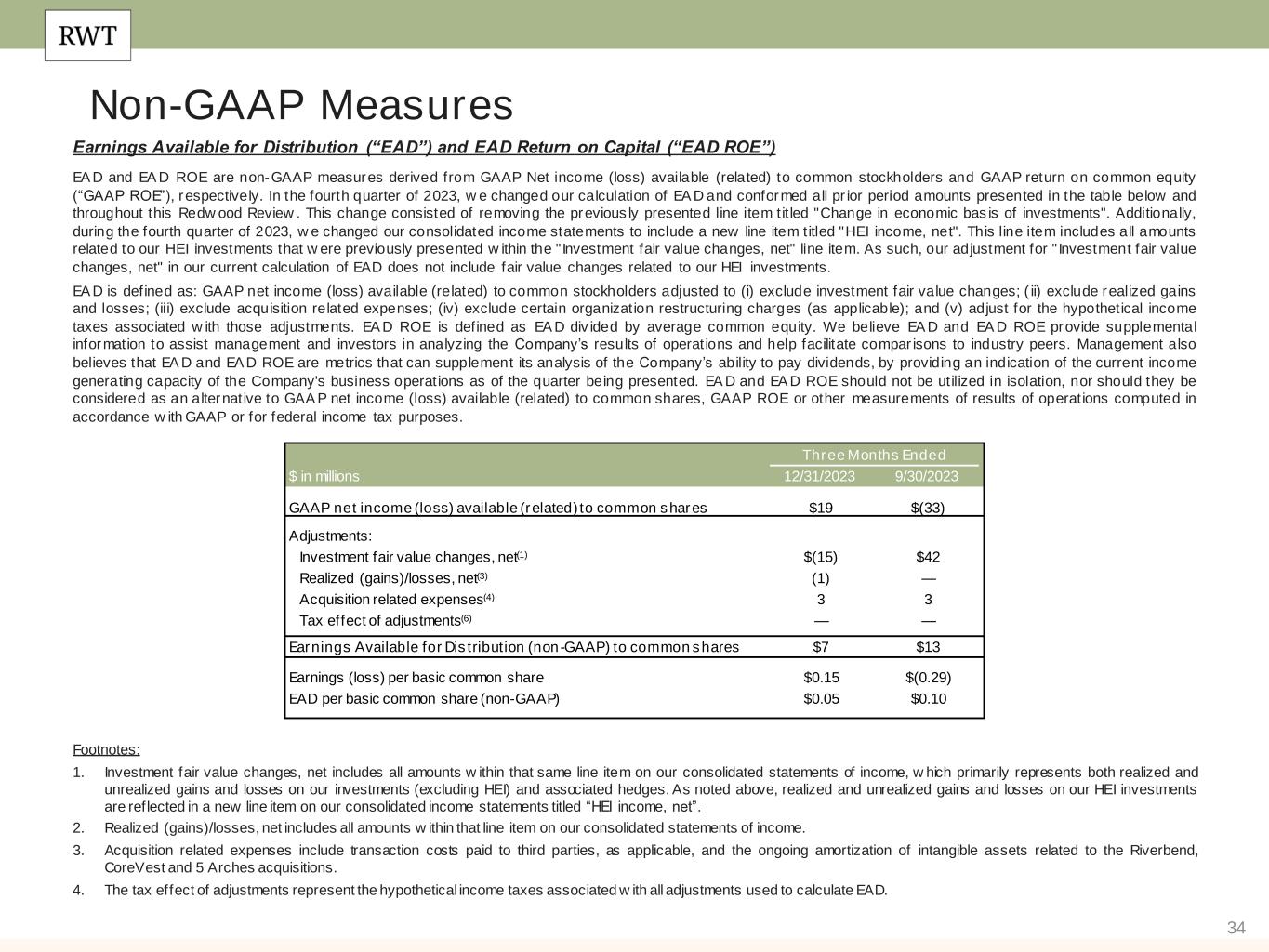
34 Non-GAAP Measures Earnings Available for Distribution (“EAD”) and EAD Return on Capital (“EAD ROE”) EA D and EA D ROE are non-GAAP measures derived from GAAP Net income (loss) available (related) to common stockholders and GAAP return on common equity (“GAAP ROE”), respectively. In the fourth quarter of 2023, w e changed our calculation of EA D and conformed all pr ior period amounts presented in the table below and throughout this Redw ood Review . This change consisted of removing the previous ly presented line item tit led "Change in economic bas is of investments". Additionally, during the fourth quarter of 2023, w e changed our consolidated income statements to include a new line item titled "HEI income, net". This line item includes all amounts related to our HEI investments that w ere previously presented w ithin the " Investment fair value changes, net" line item. As such, our adjustment for " Investment fair value changes, net" in our current calculation of EAD does not include fair value changes related to our HEI investments. EA D is defined as: GAAP net income (loss) available (related) to common stockholders adjusted to (i) exclude investment fair value changes; ( ii) exclude realized gains and losses; (iii) exclude acquisition related expenses; (iv) exclude certain organization restructuring charges (as applicable); and (v) adjust for the hypothetical income taxes associated w ith those adjustments. EA D ROE is defined as EA D div ided by average common equity. We believe EA D and EA D ROE provide supplemental information to assist management and investors in analyzing the Company’s results of operations and help facilitate compar isons to industry peers. Management also believes that EA D and EA D ROE are metrics that can supplement its analysis of the Company’s ability to pay dividends, by providing an indication of the current income generating capacity of the Company's business operations as of the quarter being presented. EA D and EA D ROE should not be utilized in isolation, nor should they be considered as an alternative to GAA P net income (loss) available (related) to common shares, GAAP ROE or other measurements of results of operations computed in accordance w ith GAAP or for federal income tax purposes. $ in millions Footnotes: 1. Investment fair value changes, net includes all amounts w ithin that same line item on our consolidated statements of income, w hich primarily represents both realized and unrealized gains and losses on our investments (excluding HEI) and associated hedges. As noted above, realized and unrealized gains and losses on our HEI investments are reflected in a new line item on our consolidated income statements titled “HEI income, net”. 2. Realized (gains)/losses, net includes all amounts w ithin that line item on our consolidated statements of income. 3. Acquisition related expenses include transaction costs paid to third parties, as applicable, and the ongoing amortization of intangible assets related to the Riverbend, CoreVest and 5 Arches acquisitions. 4. The tax effect of adjustments represent the hypothetical income taxes associated w ith all adjustments used to calculate EAD. Three Months Ended $ in millions 12/31/2023 9/30/2023 GAAP net income (loss) available (related) to common shares $19 $(33) Adjustments: Investment fair value changes, net(1) $(15) $42 Realized (gains)/losses, net(3) (1) — Acquisition related expenses(4) 3 3 Tax effect of adjustments(6) — — Earnings Available for Distribution (non-GAAP) to common shares $7 $13 Earnings (loss) per basic common share $0.15 $(0.29) EAD per basic common share (non-GAAP) $0.05 $0.10
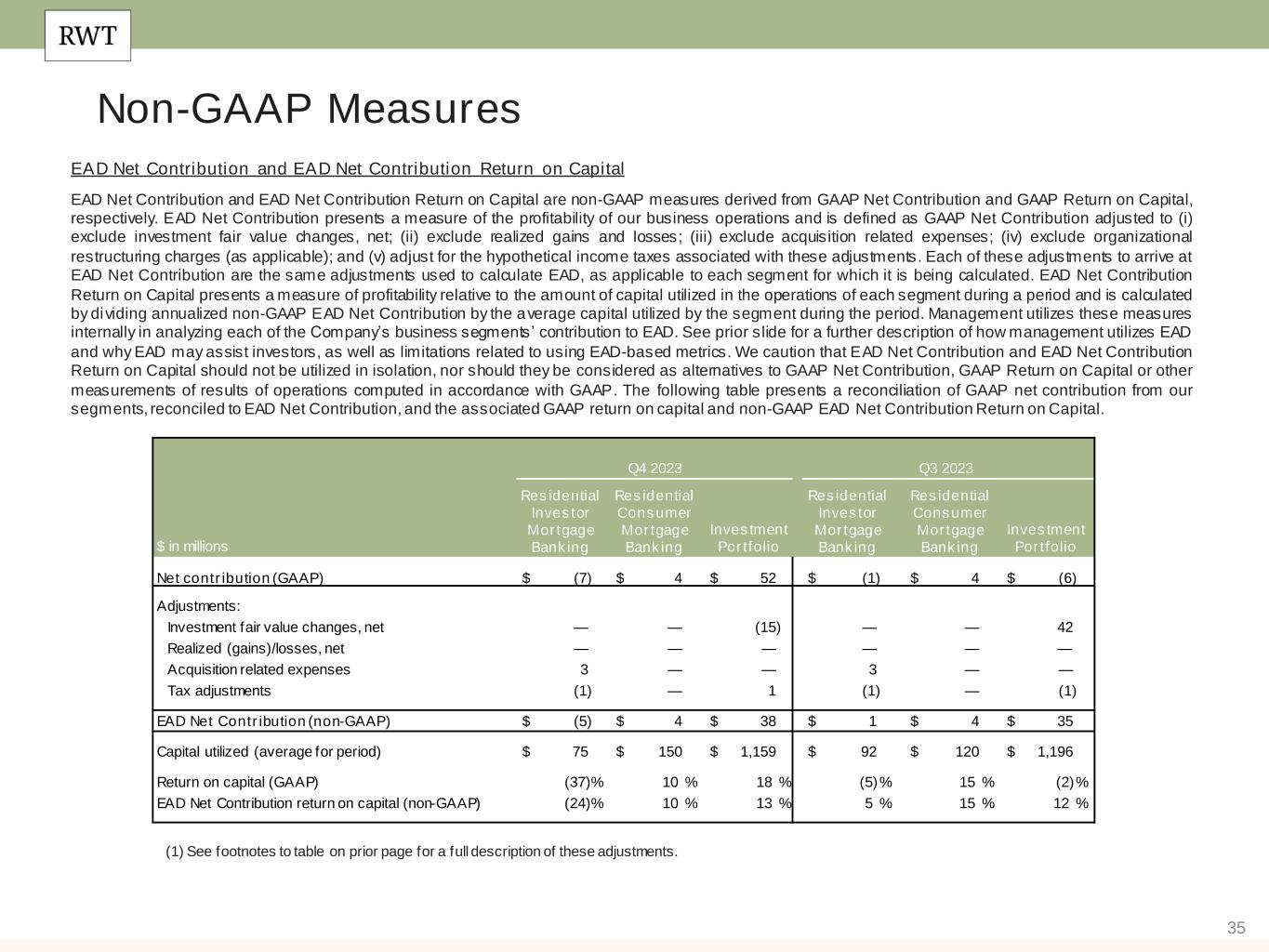
35 Non-GAAP Measures EAD Net Contribution and EAD Net Contribution Return on Capital EAD Net Contribution and EAD Net Contribution Return on Capital are non-GAAP measures derived from GAAP Net Contribution and GAAP Return on Capital, respectively. EAD Net Contribution presents a measure of the profitability of our business operations and is defined as GAAP Net Contribution adjusted to (i) exclude investment fair value changes, net; (ii) exclude realized gains and losses; (iii) exclude acquisition related expenses; (iv) exclude organizational restructuring charges (as applicable); and (v) adjust for the hypothetical income taxes associated with these adjustments. Each of these adjustments to arrive at EAD Net Contribution are the same adjustments used to calculate EAD, as applicable to each segment for which it is being calculated. EAD Net Contribution Return on Capital presents a measure of profitability relative to the amount of capital utilized in the operations of each segment during a period and is calculated by dividing annualized non-GAAP EAD Net Contribution by the average capital utilized by the segment during the period. Management utilizes these measures internally in analyzing each of the Company’s business segments’ contribution to EAD. See prior slide for a further description of how management utilizes EAD and why EAD may assist investors, as well as limitations related to using EAD-based metrics. We caution that EAD Net Contribution and EAD Net Contribution Return on Capital should not be utilized in isolation, nor should they be considered as alternatives to GAAP Net Contribution, GAAP Return on Capital or other measurements of results of operations computed in accordance with GAAP. The following table presents a reconciliation of GAAP net contribution from our segments, reconciled to EAD Net Contribution, and the associated GAAP return on capital and non-GAAP EAD Net Contribution Return on Capital. (1) See footnotes to table on prior page for a full description of these adjustments. $ in millions Q4 2023 Q3 2023 $ in millions Residential Investor Mortgage Banking Residential Consumer Mortgage Banking Investment Portfolio Residential Investor Mortgage Banking Residential Consumer Mortgage Banking Investment Portfolio Net contribution (GAAP) $ (7) $ 4 $ 52 $ (1) $ 4 $ (6) Adjustments: Investment fair value changes, net — — (15) — — 42 Realized (gains)/losses, net — — — — — — Acquisition related expenses 3 — — 3 — — Tax adjustments (1) — 1 (1) — (1) EAD Net Contribution (non-GAAP) $ (5) $ 4 $ 38 $ 1 $ 4 $ 35 Capital utilized (average for period) $ 75 $ 150 $ 1,159 $ 92 $ 120 $ 1,196 Return on capital (GAAP) (37)% 10 % 18 % (5)% 15 % (2)% EAD Net Contribution return on capital (non-GAAP) (24)% 10 % 13 % 5 % 15 % 12 %
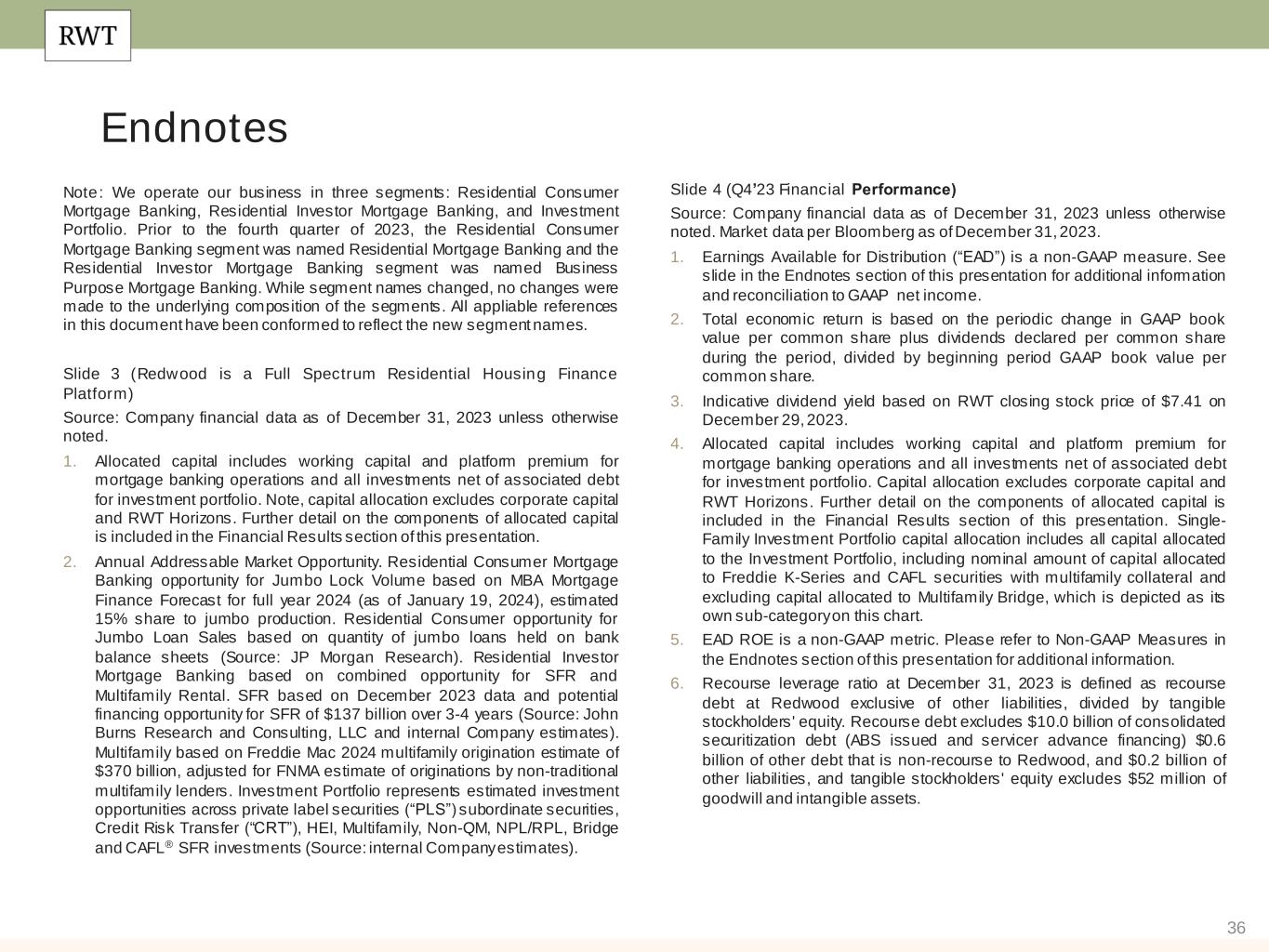
36 Note: We operate our business in three segments: Residential Consumer Mortgage Banking, Residential Investor Mortgage Banking, and Investment Portfolio. Prior to the fourth quarter of 2023, the Residential Consumer Mortgage Banking segment was named Residential Mortgage Banking and the Residential Investor Mortgage Banking segment was named Business Purpose Mortgage Banking. While segment names changed, no changes were made to the underlying composition of the segments. All appliable references in this document have been conformed to reflect the new segment names. Slide 3 (Redwood is a Full Spectrum Residential Housing Finance Platform) Source: Company financial data as of December 31, 2023 unless otherwise noted. 1. Allocated capital includes working capital and platform premium for mortgage banking operations and all investments net of associated debt for investment portfolio. Note, capital allocation excludes corporate capital and RWT Horizons. Further detail on the components of allocated capital is included in the Financial Results section of this presentation. 2. Annual Addressable Market Opportunity. Residential Consumer Mortgage Banking opportunity for Jumbo Lock Volume based on MBA Mortgage Finance Forecast for full year 2024 (as of January 19, 2024), estimated 15% share to jumbo production. Residential Consumer opportunity for Jumbo Loan Sales based on quantity of jumbo loans held on bank balance sheets (Source: JP Morgan Research). Residential Investor Mortgage Banking based on combined opportunity for SFR and Multifamily Rental. SFR based on December 2023 data and potential financing opportunity for SFR of $137 billion over 3-4 years (Source: John Burns Research and Consulting, LLC and internal Company estimates). Multifamily based on Freddie Mac 2024 multifamily origination estimate of $370 billion, adjusted for FNMA estimate of originations by non-traditional multifamily lenders. Investment Portfolio represents estimated investment opportunities across private label securities (“PLS”) subordinate securities, Credit Risk Transfer (“CRT”), HEI, Multifamily, Non-QM, NPL/RPL, Bridge and CAFL® SFR investments (Source: internal Company estimates). Endnotes Slide 4 (Q4’23 Financial Performance) Source: Company financial data as of December 31, 2023 unless otherwise noted. Market data per Bloomberg as of December 31, 2023. 1. Earnings Available for Distribution (“EAD”) is a non-GAAP measure. See slide in the Endnotes section of this presentation for additional information and reconciliation to GAAP net income. 2. Total economic return is based on the periodic change in GAAP book value per common share plus dividends declared per common share during the period, divided by beginning period GAAP book value per common share. 3. Indicative dividend yield based on RWT closing stock price of $7.41 on December 29, 2023. 4. Allocated capital includes working capital and platform premium for mortgage banking operations and all investments net of associated debt for investment portfolio. Capital allocation excludes corporate capital and RWT Horizons. Further detail on the components of allocated capital is included in the Financial Results section of this presentation. Single- Family Investment Portfolio capital allocation includes all capital allocated to the Investment Portfolio, including nominal amount of capital allocated to Freddie K-Series and CAFL securities with multifamily collateral and excluding capital allocated to Multifamily Bridge, which is depicted as its own sub-category on this chart. 5. EAD ROE is a non-GAAP metric. Please refer to Non-GAAP Measures in the Endnotes section of this presentation for additional information. 6. Recourse leverage ratio at December 31, 2023 is defined as recourse debt at Redwood exclusive of other liabilities, divided by tangible stockholders' equity. Recourse debt excludes $10.0 billion of consolidated securitization debt (ABS issued and servicer advance financing) $0.6 billion of other debt that is non-recourse to Redwood, and $0.2 billion of other liabilities, and tangible stockholders' equity excludes $52 million of goodwill and intangible assets.
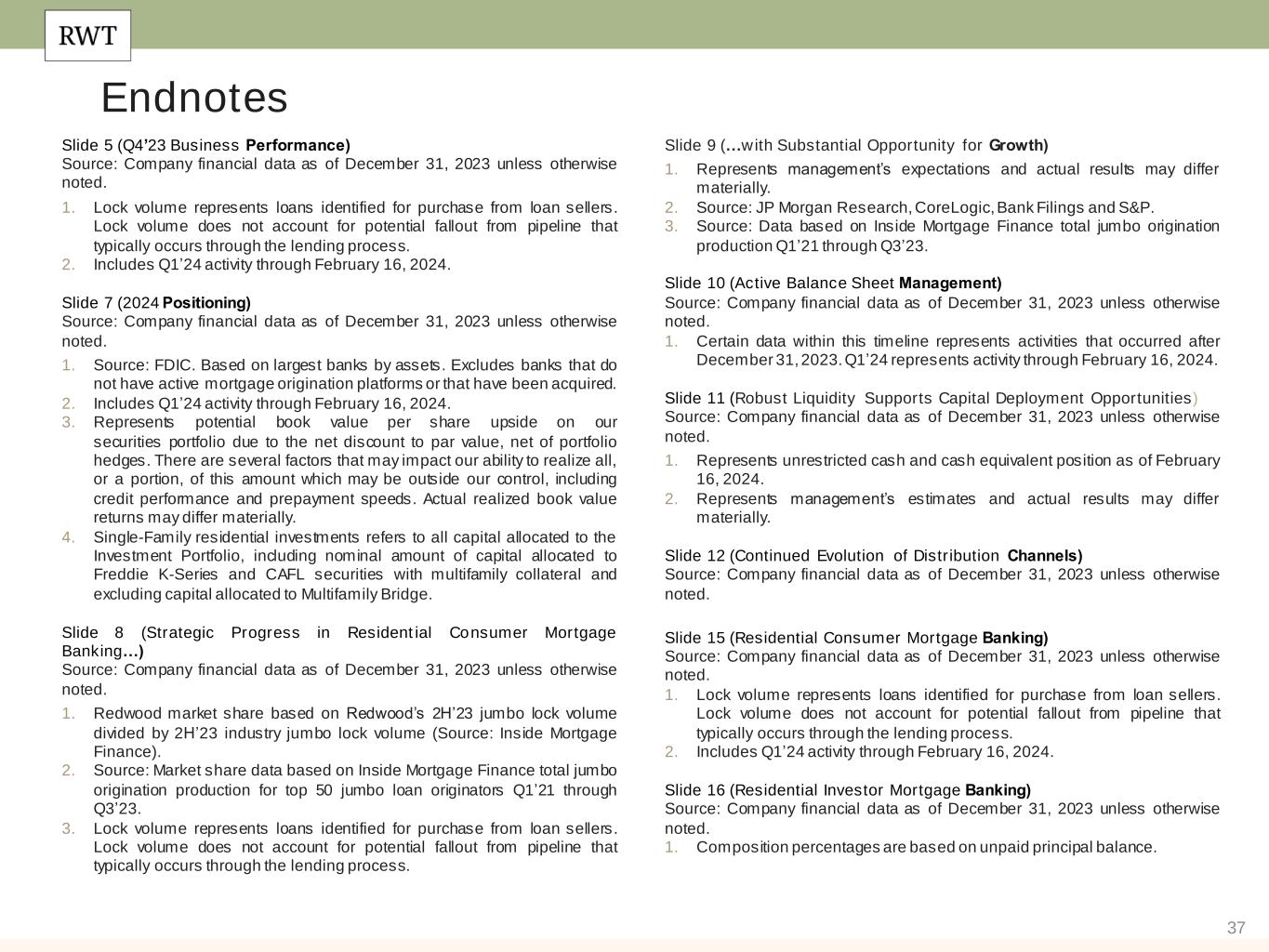
37 Endnotes Slide 5 (Q4’23 Business Performance) Source: Company financial data as of December 31, 2023 unless otherwise noted. 1. Lock volume represents loans identified for purchase from loan sellers. Lock volume does not account for potential fallout from pipeline that typically occurs through the lending process. 2. Includes Q1’24 activity through February 16, 2024. Slide 7 (2024 Positioning) Source: Company financial data as of December 31, 2023 unless otherwise noted. 1. Source: FDIC. Based on largest banks by assets. Excludes banks that do not have active mortgage origination platforms or that have been acquired. 2. Includes Q1’24 activity through February 16, 2024. 3. Represents potential book value per share upside on our securities portfolio due to the net discount to par value, net of portfolio hedges. There are several factors that may impact our ability to realize all, or a portion, of this amount which may be outside our control, including credit performance and prepayment speeds. Actual realized book value returns may differ materially. 4. Single-Family residential investments refers to all capital allocated to the Investment Portfolio, including nominal amount of capital allocated to Freddie K-Series and CAFL securities with multifamily collateral and excluding capital allocated to Multifamily Bridge. Slide 8 (Strategic Progress in Residential Consumer Mortgage Banking…) Source: Company financial data as of December 31, 2023 unless otherwise noted. 1. Redwood market share based on Redwood’s 2H’23 jumbo lock volume divided by 2H’23 industry jumbo lock volume (Source: Inside Mortgage Finance). 2. Source: Market share data based on Inside Mortgage Finance total jumbo origination production for top 50 jumbo loan originators Q1’21 through Q3’23. 3. Lock volume represents loans identified for purchase from loan sellers. Lock volume does not account for potential fallout from pipeline that typically occurs through the lending process. Slide 9 (…with Substantial Opportunity for Growth) 1. Represents management’s expectations and actual results may differ materially. 2. Source: JP Morgan Research, CoreLogic, Bank Filings and S&P. 3. Source: Data based on Inside Mortgage Finance total jumbo origination production Q1’21 through Q3’23. Slide 10 (Active Balance Sheet Management) Source: Company financial data as of December 31, 2023 unless otherwise noted. 1. Certain data within this timeline represents activities that occurred after December 31, 2023. Q1’24 represents activity through February 16, 2024. Slide 11 (Robust Liquidity Supports Capital Deployment Opportunities) Source: Company financial data as of December 31, 2023 unless otherwise noted. 1. Represents unrestricted cash and cash equivalent position as of February 16, 2024. 2. Represents management’s estimates and actual results may differ materially. Slide 12 (Continued Evolution of Distribution Channels) Source: Company financial data as of December 31, 2023 unless otherwise noted. Slide 15 (Residential Consumer Mortgage Banking) Source: Company financial data as of December 31, 2023 unless otherwise noted. 1. Lock volume represents loans identified for purchase from loan sellers. Lock volume does not account for potential fallout from pipeline that typically occurs through the lending process. 2. Includes Q1’24 activity through February 16, 2024. Slide 16 (Residential Investor Mortgage Banking) Source: Company financial data as of December 31, 2023 unless otherwise noted. 1. Composition percentages are based on unpaid principal balance.
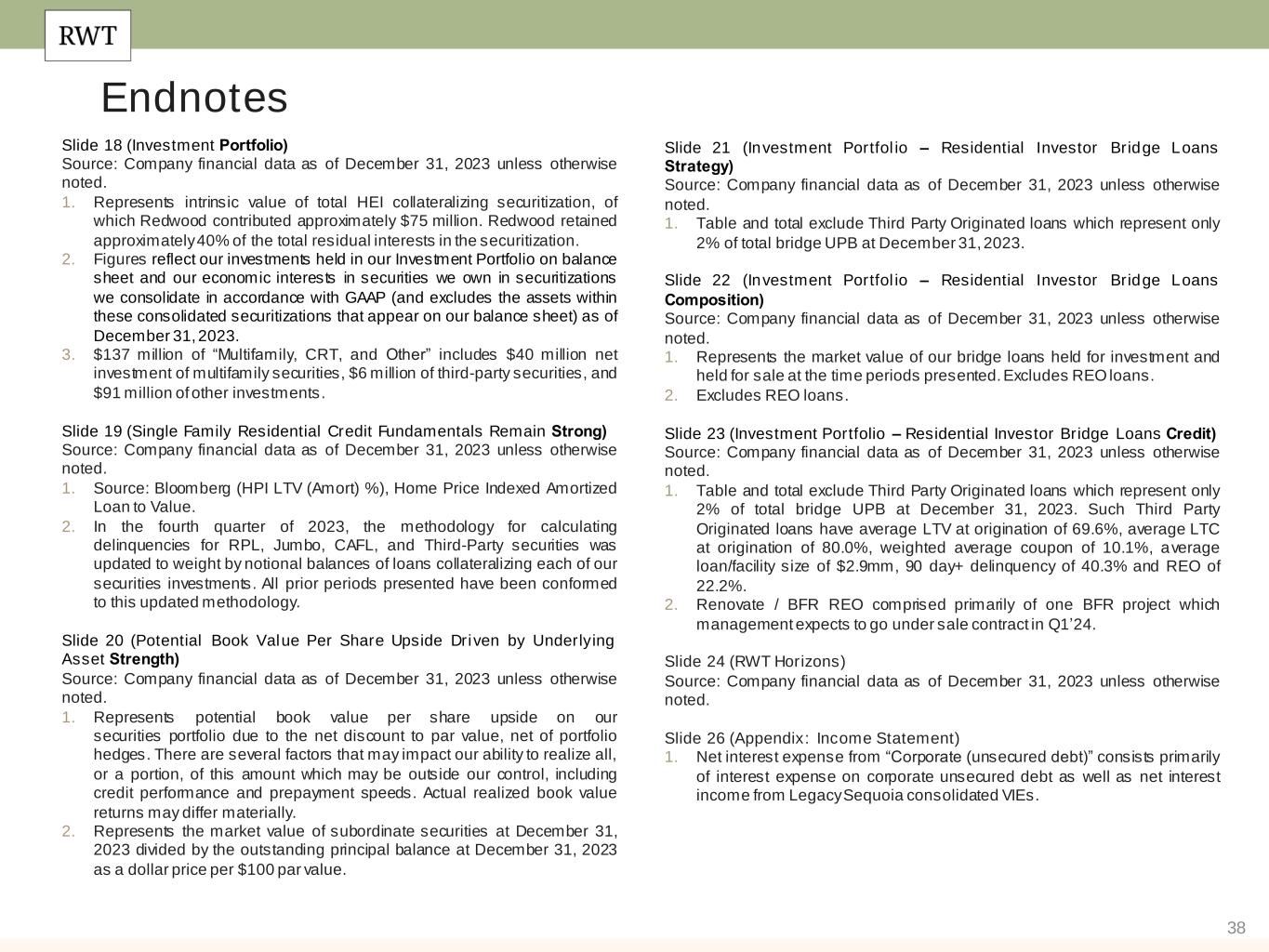
38 Endnotes Slide 18 (Investment Portfolio) Source: Company financial data as of December 31, 2023 unless otherwise noted. 1. Represents intrinsic value of total HEI collateralizing securitization, of which Redwood contributed approximately $75 million. Redwood retained approximately 40% of the total residual interests in the securitization. 2. Figures reflect our investments held in our Investment Portfolio on balance sheet and our economic interests in securities we own in securitizations we consolidate in accordance with GAAP (and excludes the assets within these consolidated securitizations that appear on our balance sheet) as of December 31, 2023. 3. $137 million of “Multifamily, CRT, and Other” includes $40 million net investment of multifamily securities, $6 million of third-party securities, and $91 million of other investments. Slide 19 (Single Family Residential Credit Fundamentals Remain Strong) Source: Company financial data as of December 31, 2023 unless otherwise noted. 1. Source: Bloomberg (HPI LTV (Amort) %), Home Price Indexed Amortized Loan to Value. 2. In the fourth quarter of 2023, the methodology for calculating delinquencies for RPL, Jumbo, CAFL, and Third-Party securities was updated to weight by notional balances of loans collateralizing each of our securities investments. All prior periods presented have been conformed to this updated methodology. Slide 20 (Potential Book Value Per Share Upside Driven by Underlying Asset Strength) Source: Company financial data as of December 31, 2023 unless otherwise noted. 1. Represents potential book value per share upside on our securities portfolio due to the net discount to par value, net of portfolio hedges. There are several factors that may impact our ability to realize all, or a portion, of this amount which may be outside our control, including credit performance and prepayment speeds. Actual realized book value returns may differ materially. 2. Represents the market value of subordinate securities at December 31, 2023 divided by the outstanding principal balance at December 31, 2023 as a dollar price per $100 par value. Slide 21 (Investment Portfolio – Residential Investor Bridge Loans Strategy) Source: Company financial data as of December 31, 2023 unless otherwise noted. 1. Table and total exclude Third Party Originated loans which represent only 2% of total bridge UPB at December 31, 2023. Slide 22 (Investment Portfolio – Residential Investor Bridge Loans Composition) Source: Company financial data as of December 31, 2023 unless otherwise noted. 1. Represents the market value of our bridge loans held for investment and held for sale at the time periods presented. Excludes REO loans. 2. Excludes REO loans. Slide 23 (Investment Portfolio – Residential Investor Bridge Loans Credit) Source: Company financial data as of December 31, 2023 unless otherwise noted. 1. Table and total exclude Third Party Originated loans which represent only 2% of total bridge UPB at December 31, 2023. Such Third Party Originated loans have average LTV at origination of 69.6%, average LTC at origination of 80.0%, weighted average coupon of 10.1%, average loan/facility size of $2.9mm, 90 day+ delinquency of 40.3% and REO of 22.2%. 2. Renovate / BFR REO comprised primarily of one BFR project which management expects to go under sale contract in Q1’24. Slide 24 (RWT Horizons) Source: Company financial data as of December 31, 2023 unless otherwise noted. Slide 26 (Appendix: Income Statement) 1. Net interest expense from “Corporate (unsecured debt)” consists primarily of interest expense on corporate unsecured debt as well as net interest income from Legacy Sequoia consolidated VIEs.
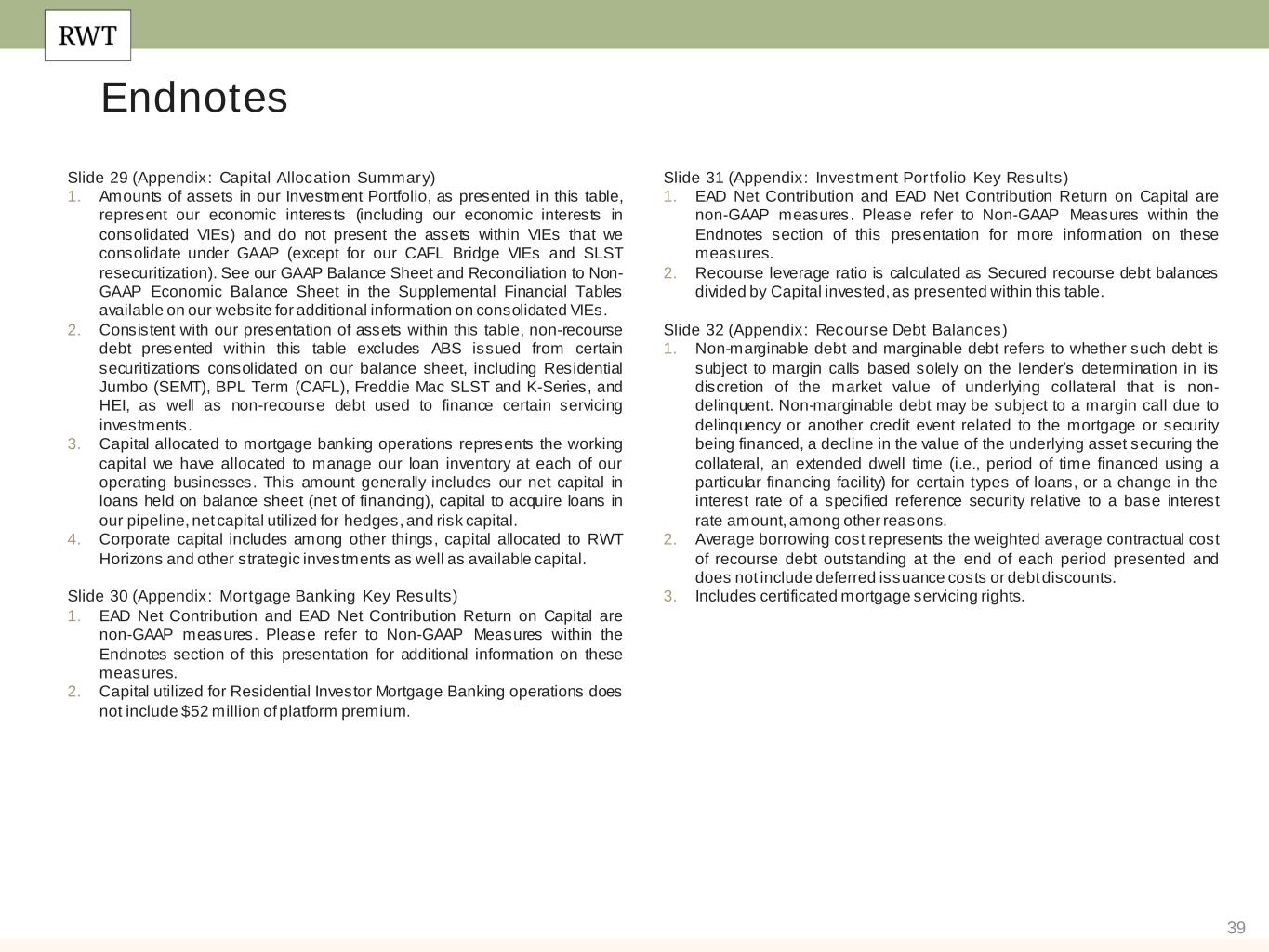
39 Endnotes Slide 29 (Appendix: Capital Allocation Summary) 1. Amounts of assets in our Investment Portfolio, as presented in this table, represent our economic interests (including our economic interests in consolidated VIEs) and do not present the assets within VIEs that we consolidate under GAAP (except for our CAFL Bridge VIEs and SLST resecuritization). See our GAAP Balance Sheet and Reconciliation to Non- GAAP Economic Balance Sheet in the Supplemental Financial Tables available on our website for additional information on consolidated VIEs. 2. Consistent with our presentation of assets within this table, non-recourse debt presented within this table excludes ABS issued from certain securitizations consolidated on our balance sheet, including Residential Jumbo (SEMT), BPL Term (CAFL), Freddie Mac SLST and K-Series, and HEI, as well as non-recourse debt used to finance certain servicing investments. 3. Capital allocated to mortgage banking operations represents the working capital we have allocated to manage our loan inventory at each of our operating businesses. This amount generally includes our net capital in loans held on balance sheet (net of financing), capital to acquire loans in our pipeline, net capital utilized for hedges, and risk capital. 4. Corporate capital includes among other things, capital allocated to RWT Horizons and other strategic investments as well as available capital. Slide 30 (Appendix: Mortgage Banking Key Results) 1. EAD Net Contribution and EAD Net Contribution Return on Capital are non-GAAP measures. Please refer to Non-GAAP Measures within the Endnotes section of this presentation for additional information on these measures. 2. Capital utilized for Residential Investor Mortgage Banking operations does not include $52 million of platform premium. Slide 31 (Appendix: Investment Portfolio Key Results) 1. EAD Net Contribution and EAD Net Contribution Return on Capital are non-GAAP measures. Please refer to Non-GAAP Measures within the Endnotes section of this presentation for more information on these measures. 2. Recourse leverage ratio is calculated as Secured recourse debt balances divided by Capital invested, as presented within this table. Slide 32 (Appendix: Recourse Debt Balances) 1. Non-marginable debt and marginable debt refers to whether such debt is subject to margin calls based solely on the lender’s determination in its discretion of the market value of underlying collateral that is non- delinquent. Non-marginable debt may be subject to a margin call due to delinquency or another credit event related to the mortgage or security being financed, a decline in the value of the underlying asset securing the collateral, an extended dwell time (i.e., period of time financed using a particular financing facility) for certain types of loans, or a change in the interest rate of a specified reference security relative to a base interest rate amount, among other reasons. 2. Average borrowing cost represents the weighted average contractual cost of recourse debt outstanding at the end of each period presented and does not include deferred issuance costs or debt discounts. 3. Includes certificated mortgage servicing rights.
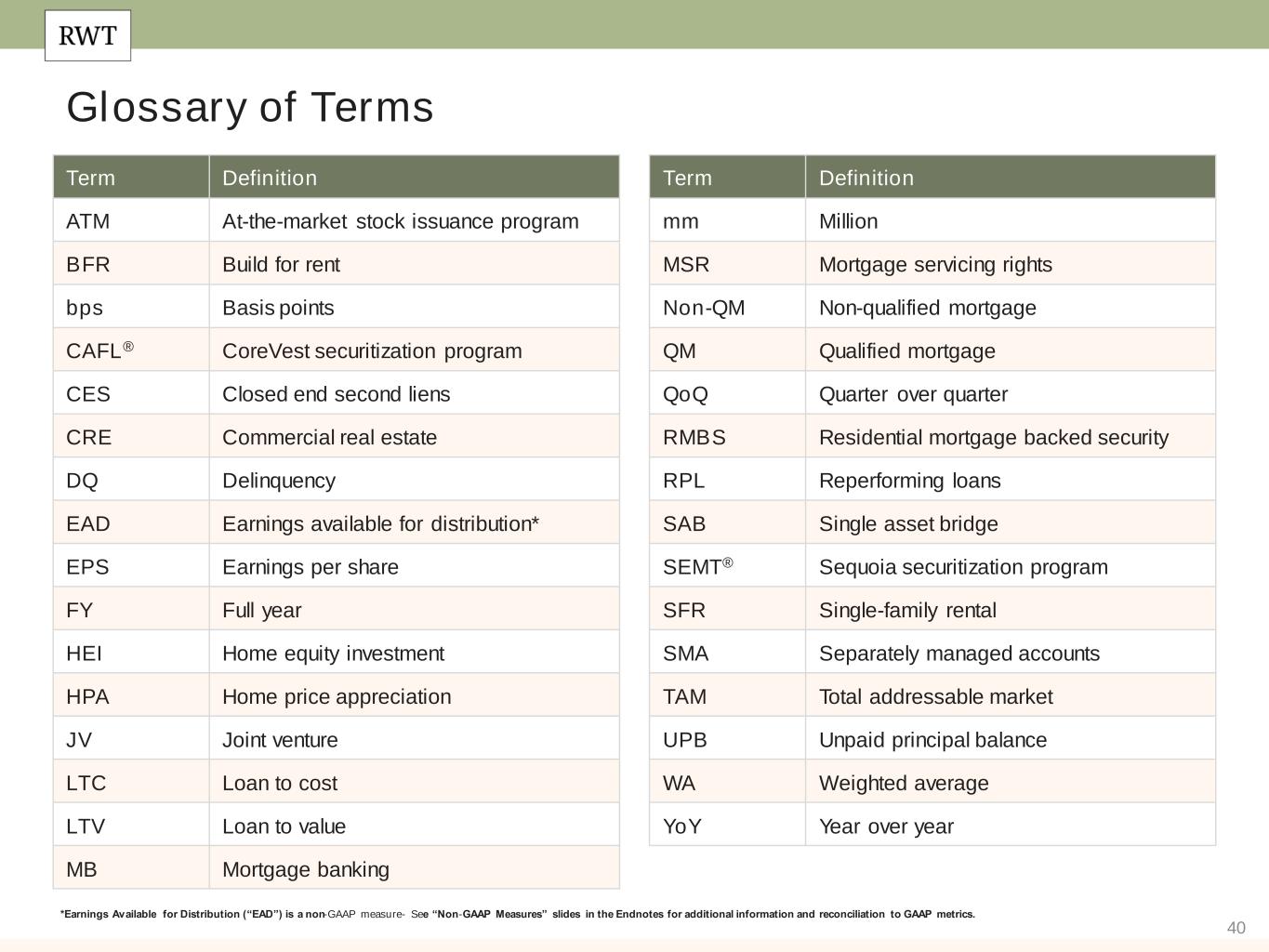
40 Glossary of Terms Term Definition ATM At-the-market stock issuance program BFR Build for rent bps Basis points CAFL® CoreVest securitization program CES Closed end second liens CRE Commercial real estate DQ Delinquency EAD Earnings available for distribution* EPS Earnings per share FY Full year HEI Home equity investment HPA Home price appreciation JV Joint venture LTC Loan to cost LTV Loan to value MB Mortgage banking Term Definition mm Million MSR Mortgage servicing rights Non-QM Non-qualified mortgage QM Qualified mortgage QoQ Quarter over quarter RMBS Residential mortgage backed security RPL Reperforming loans SAB Single asset bridge SEMT® Sequoia securitization program SFR Single-family rental SMA Separately managed accounts TAM Total addressable market UPB Unpaid principal balance WA Weighted average YoY Year over year *Earnings Available for Distribution (“EAD”) is a non-GAAP measure- See “Non-GAAP Measures” slides in the Endnotes for additional information and reconciliation to GAAP metrics.